- Retour accueil
- Vous êtes ici : Blog The Pyramids of the Cold v2 The Pyramids of the Cold v2 • Section 47 The Aegis Shield of Athena 'Subduer of the Winds' and the upper hatch of the Gallery
The Pyramids of the Cold v2 • Section 47 The Aegis Shield of Athena 'Subduer of the Winds' and the upper hatch of the Gallery
Publié par Bruno Coursol dans The Pyramids of the Cold v2 le 06/04/2024 à 11:23

The Shield of Athena and the head of the Gorgon onto that Shield are all about her being called “the Subduer of the Winds”: the aegis Shield of Athena was the Greek reinterpretation of the upper hatch of the central wooden wind pipe caisson without which the caisson wouldn’t have been able to contain pressurized air... and the Pyramid to breathe.
The upper south end of the Grand Gallery in the Great Pyramid of Giza. Great Pyramid Passages Volume 1, 1910 edition by John and Morton Edgar, Plate CXVI page 238: https://archive.org/details/GreatPyramidPassagesVol11910Edition/page/n247/mode/1up?view=theater
Shield of Athena Parthenos at Parthenon replica in Nashville, Tennessee, sculpted by Alan LeQuire, 1990. Photograph by Atlabar: https://commons.wikimedia.org/wiki/File:Shield_of_Athena_Parthenos,_Nashville.jpg
The Pyramids of the Cold v2 (May 2023-April 2024) • The Magicians of the Great Pyramid
Section 47 • The Aegis Shield of Athena and the upper internal hatch of the central wooden wind pipe caisson
In summary: because I’m not a engineer, I only focused myself on the lower part of the central wooden caisson of the Grand Gallery, because it was obvious that a hatch had to be implemented there, so that the impactor would be able to be reconnected with the two hauling ropes. I didn’t care that much about the upper part, because again I didn’t think it was possible to “reconstruct” what ever piece of equipment was there to seal the caisson before the release of the impactor.
Because both water and the two central hauling ropes were getting inside the caisson from its upper end, it wouldn’t have been able to keep pressurized air inside its wooden structure without a heavy internal hatch: they needed to seal the caisson. In short, there had to be a second hatch, and if the first one, the lower hatch (the Bastet hatch), was a simple “door” set onto the wooden structure (the cat flap metaphor about the cat goddess Bastet), this one, the upper hatch had to be completely inside the structure. The upper hatch was an internal hatch and it had to function just like a sluice gate.
Without this upper hatch, there would have been no possible renewal of the moist air produced by the evaporative cooling process, and the cycle of cold production would have stopped right away after the first cycle. In other words, this upper hatch made the central wooden caisson able to breathe fresh air, and its sluice gate was the key of that part of the process.
We’ll see that the reconstruction of the upper end of the caisson is actually still possible today, because just like everything we’ve already seen in this study, ancient Egyptians glorified every single part of the operation process of the upper hatch into many gods and goddesses: Neith, Serket, Tutu and Sekhmet are all about this hatch.
We’ll see that because of the lack of understanding of this upper end of the caisson, I have to make another mea culpa for the umpteenth time about Sekhmet and that many answers can be found in the Greek mythology: every historian knows that Greek deities are nothing but the complete assimilations and reinterpretations of ancient Egyptian deities, through a process called “Interpretatio Graeca”.
This assimilation process of ancient Egyptian gods and goddesses by Greeks is essential, because the same thing happened all over the ancient World, just like I’ve already had the occasion to discuss with the Norse mythology, the Hindu mythology and the Tibetan mythology.
Even if this assimilation process is known by everybody, strangely, no one is taking advantage of it. For example, everybody knows that Greek goddess Athena is the reinterpretation of the ancient Egyptian goddess Neith, but apparently no one is trying to understand any of them by considering them as a unique entity. And that is intellectual suicide, because Neith/Athena and their Aegis/Shield are the key for the "reconstruction" of the upper end of the central wooden caisson of the Gallery: the Shield of Athena really is the upper hatch.
And of course, if Athena was called “the Subduer of the Winds”, it is because the Shield of Athena, as the upper hatch of the wind pipe caisson was the one to contain pressurized air… and contain the winds. Athena is not the hatch itself, but what operated the hatch, and it wasn't ropes: "rattling and noisy" Athena is about chains made of bronze.
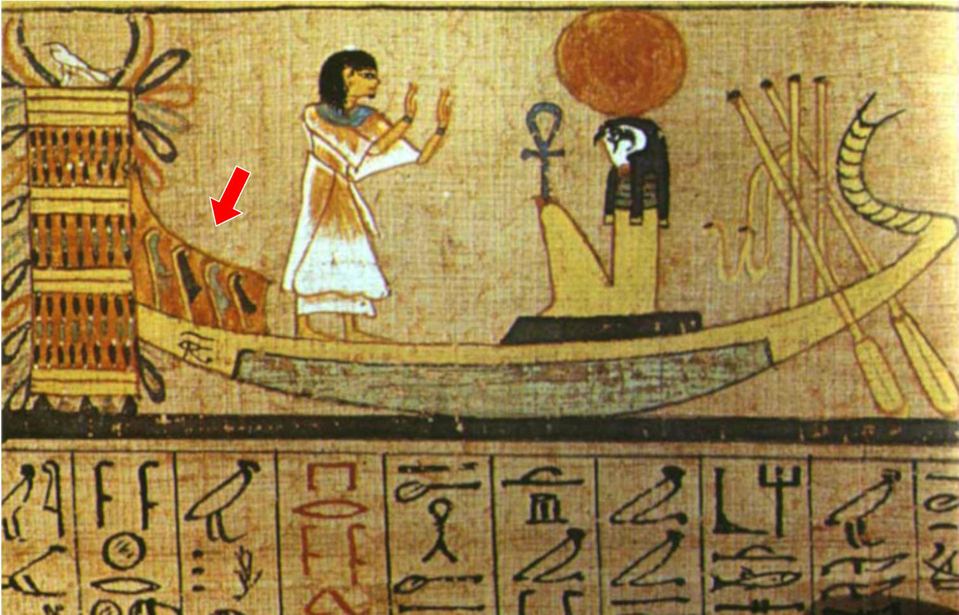
The solar barque and its strange "anchoring" element on the left which is the upper hatch itself, represented here immobilizing the boat with all its weight. Probably the blue and lower part of the Solar boat is a representation of the keel of a boat, emphasizing the fact that the Solar boat was all about transporting a very important weight: the Osiris weight (probably not in granite as I first thought but in bronze): https://www.osirisnet.net/dieux/re/re.htm
47.01 The upper internal hatch was the piece of equipment which locked and released the impactor
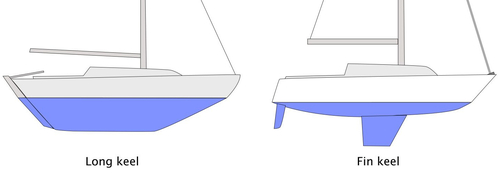
I knew about these representations of the Solar barque of Sun god Ra, or Horus-Ra, and I always was puzzled by the strange element thing at one end of the barque. Remember that the barque is only the glorification of the wooden vessel which was “carrying” the Osiris stone; the barque is the wooden part of the impactor; so I really didn’t understand what this big rectangular thing in which the boat was somehow imbedded was all about.
But I should’ve known better: since the beginning of the study, I always questioned myself how did they locked, secured and released the impactor at the end of an operating cycle of the Gallery; and it was there, right under my eyes. I simply couldn’t understand it because I didn’t know about the upper internal hatch, but this big rectangular thing that is putting its weight on the barque, that is the hatch; and that is the hatch which locked the impactor in a secure position… and then released it within the slope.
Keels of a ship: https://www.safe-skipper.com/keel-design-options-consider-choosing-yacht/
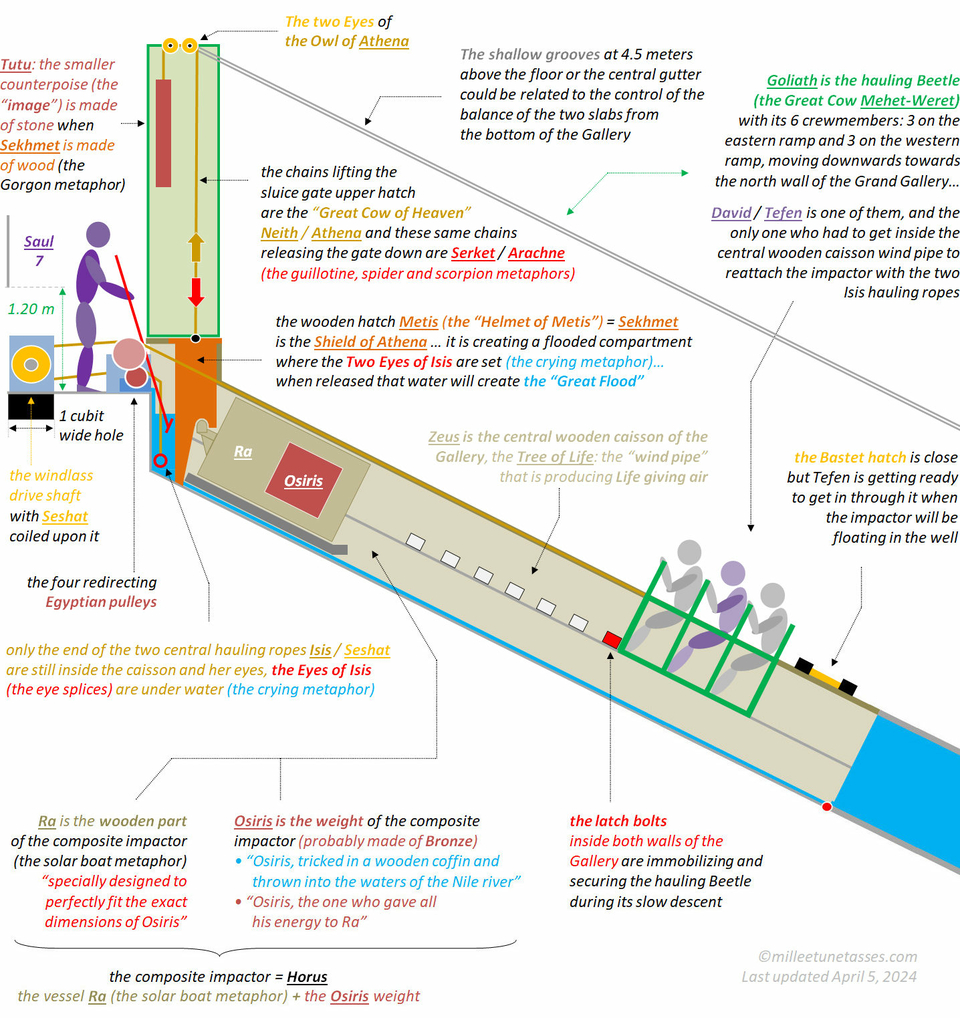
Operation of the Grand Gallery of the Great Pyramid of Giza. The impactor is locked and secure by the Sekhmet upper wooden hatch, ready to be released. The hatch is always in perfect balance with its counterpoise (that is what Ma'at is all about). On this draw two kinds of glorifications have been used: the original ancient Egyptian deities (like Ra, Osiris, Isis, Neith, Sekhmet…) and some of their Greek reinterpretations (like Athena for Neith, or the “Shield of Athena” for the upper hatch Sekhmet). Last updated April 5, 2024.
47.02 The upper hatch of the central wooden wind pipe caisson: Sekhmet
The purpose of this particular draw is only about the first attempt to recreate the upper part of the central wooden caisson with the upper hatch which was the one allowing the caisson to breathe by creating pressurized and constraint air inside the structure.
The key element is the Sekhmet hatch, a big and heavy piece of wood which would have needed a very robust wooden structure to be operated through a counterpoise and, as we'll see later, not rope(s) but chain(s) which had been glorified into goddess Neith, before being reinterpreted and incorporated in the Greek mythology in Athena through a process called the Interpretatio Graeca by academic historians.
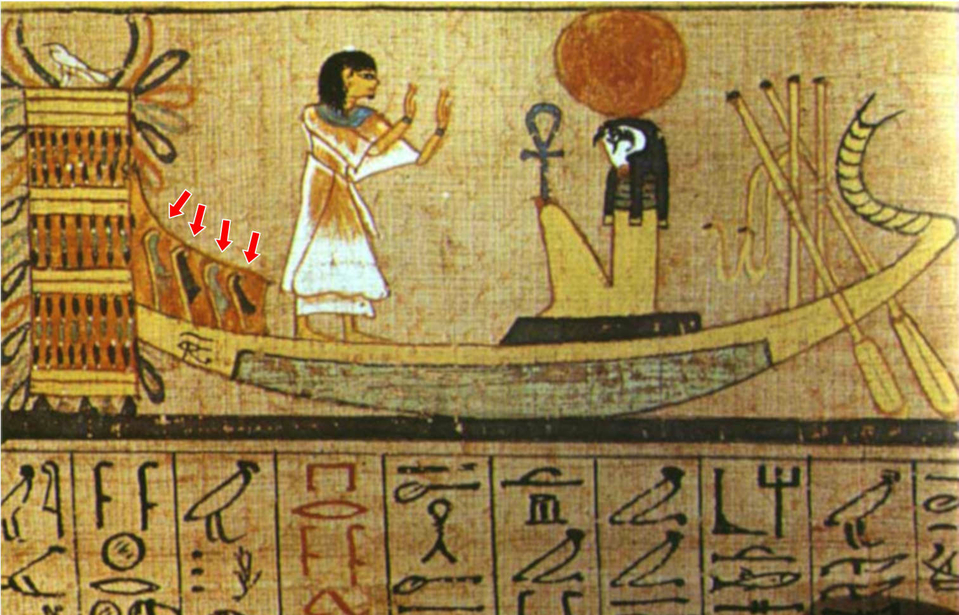
The feathers on the boat are indicating a moving part supposed to be lifted at some point. The question is: does it have to be taken literally or metaphorically... was there a moving part or not?
47.03 Was the upper internal Sekhmet hatch in one single piece or with a moving part?
We’ve seen many times in previous Sections of The Pyramids of the Cold, that wings and Angels have been used in the Jewish reinterpretation of the ancient Egyptian prowesses realized in the Grand Gallery and that they were all about ropes: under tension, the driving and hauling ropes of the Gallery never would have touch the ground and they have been glorified into Angels with beautiful wings. Angels were the “messengers of the gods”, because ropes really are messengers: they are transmitting tension and traction forces.
Ancient Egyptians did the exact same things to represent ropes (or chains) with the wings of Wadjet and Nekhbet, but they also used simple feathers, just like in the above image, to indicate that the element immobilizing the solar boat was supposed to be lifted at some point.
I may be wrong about the drawing I’ve made about the real design of the upper internal hatch of the wind pipe wooden caisson, because on the image, it looks like it was some kind of a moving part which was both securing and releasing the impactor.
I may be wrong in drawing the hatch in one single piece, but in my opinion the Egyptian drawing doesn’t have to be taken literally: it probably is only another metaphor to demonstrate the double function of the hatch and not its real design.
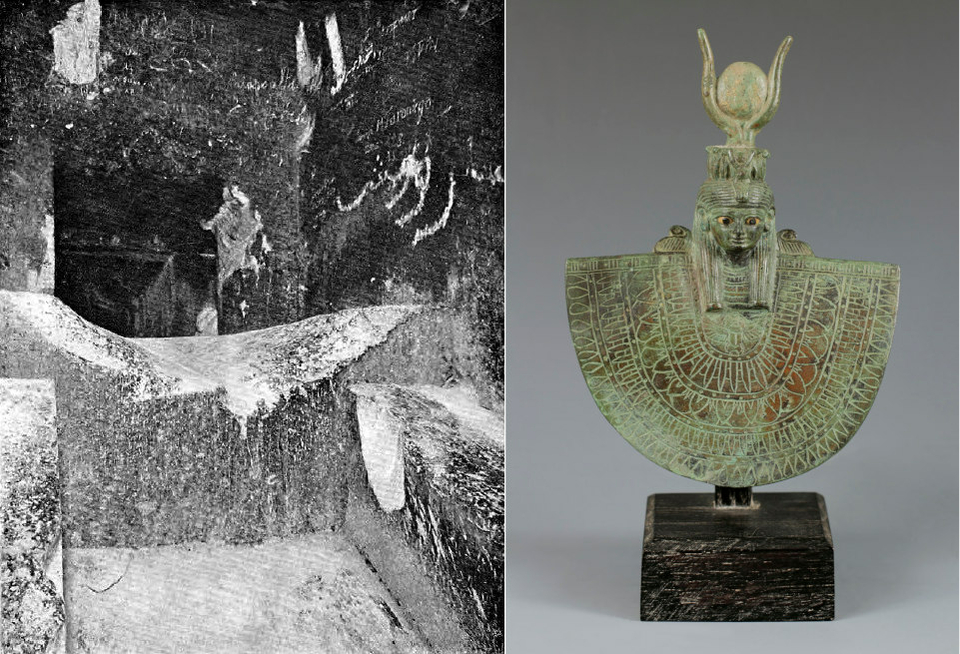
The upper south end of the Grand Gallery in the Great Pyramid of Giza. Great Pyramid Passages Volume 1, 1910 edition by John and Morton Edgar, Plate CXVI page 238: https://archive.org/details/GreatPyramidPassagesVol11910Edition/page/n247/mode/1up?view=theater
“The aegis, a combination of a deity's head and an exaggerated collar, was an emblem of the gods in ancient Egyptian culture. These images could be carried on a standard in processions or set on the prow of a sacred boat. Smaller version were worn as amulets. This aegis depicts a goddess wearing a modius, a small cap made of cobras, and cow horns with a sun disk between them. It could represent a number of goddesses such as Isis, Hathor, or some other female deity.” https://www.albanyinstitute.org/collection/details/aegis-of-the-godess-isis
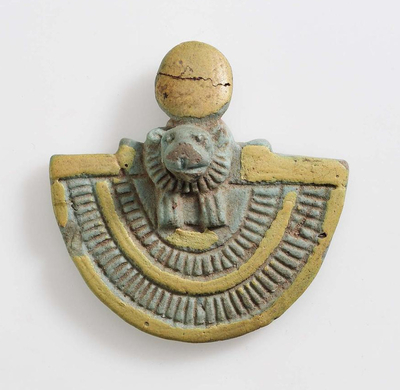
47.04 The first key: the “exaggerated broad collar” of the Aegis is not a collar, but the Big Step of the Gallery
At first, it was only an intuition, but now there is no more questioning to have about what egyptologists are describing as the “broad collar” or “exaggerated collar” of a Aegis artifact: it simply is not a collar at all, but the representation of what have been called “Big step” by some egyptologists, and that is the north end of the top platform of the Grand Gallery in the Great Pyramid.
If I was right, it meant that all the goddesses’ heads represented onto the collar, and in front of the collar actually, were all representations of these goddesses in direct interaction with this upper part of the Gallery.
For example, if you look at the side view diagram of the Grand Gallery’s operation below, you will see that there is only the head of the two Isis hauling ropes hanging down from the platform; and most of the Aegis artifacts are indeed showing the head of Isis just in front of the “broad collar”.
I have to point out that I wouldn’t have had any problem if this lead turned out to be false trail, and at first I didn’t understand the meaning of all that, until I found out that sometimes the Aegis had the head of Sekhmet instead of the “regular” Isis.
"Aegis with the head of a cat goddess, either Bastet or Tefnut" at the Museum of Fine Arts Boston [although it could also probably be the head of the other cat goddess Sekhmet]: https://collections.mfa.org/objects/136137
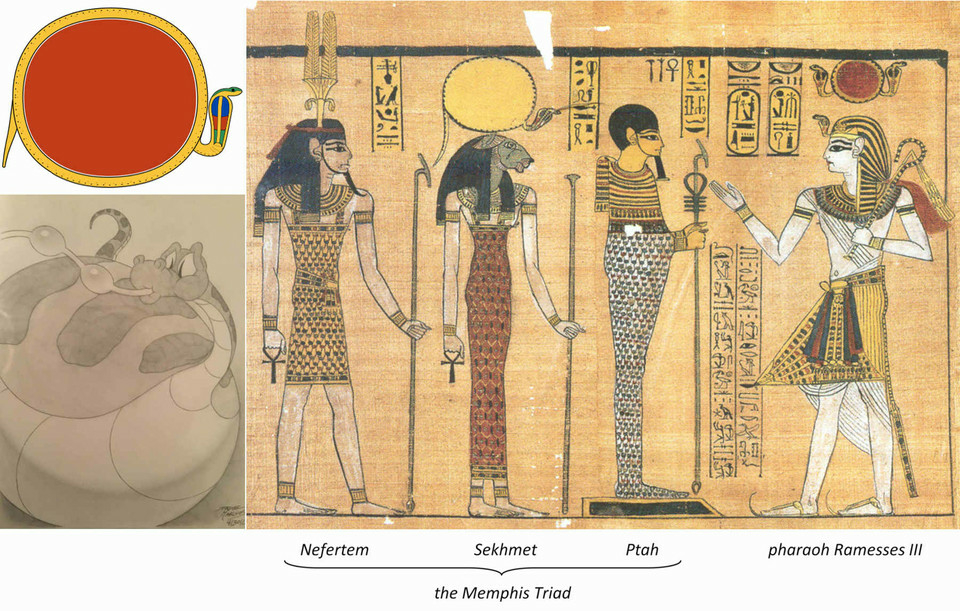
Air is the real meaning of Sekhmet’s inflated uraeus.“Snake Inflation” (Pencil Drawing, 2015) by DoodleDan86: https://www.deviantart.com/doodledan86/art/Snake-Inflation-Pencil-Drawing-2015-788697049
Pharaoh Ramsses III (on the right) and the three gods of the Memphis Triad: Nefertem (on the left), Sekhmet (center) and Ptah, facing Ramesses III: commons.wikimedia.org/wiki/File:Ramses_III_and_the_Memphis_gods.jpg
47.05 Umpteenth mea culpa: Sekhmet really is the upper internal hatch
And if Sekhmet is associated with the upper south end of the Gallery, then it means I was wrong saying that Sekhmet was the deification of pressurized air that would escape from the north lower end of the central caisson through the Bastet hatch (Section 22).
When I think it through now, I actually did the same mistake than the one I corrected in previous Section 46:
• Because I misplaced Nephthys, and have put her where Seshat should have been put (that is the two central hauling ropes coiled upon the axle drive shaft windlass), I couldn’t put Seshat where she should have been, and as a result I was forced to see Seshat like a “evolution” or a simple different way of seeing Nephthys.
• But when I stumble upon the fact that Isis was seen as “the Ascending One” and Nephthys “the Descending One”, I was able to place Nephthys at her true place, as well as Seshat instead of Nephthys.
• And now that I’m starting to apprehend the upper part of the wind pipe caisson, Sekhmet is the only one associated with the upper hatch; but interestingly there would be two hatches that would need to be associated with Bastet, simply because the Sekhmet upper internal hatch also had to have its upper end in the continuity of the caisson, just like the lower Bastet hatch.
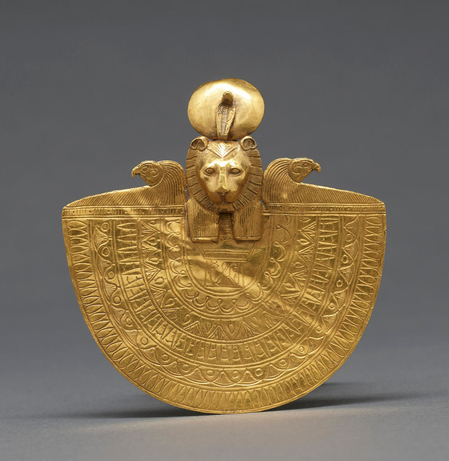
47.06 Sekhmet and the "inflated snake" are both about (pressurized) air
When you look at the above representation of Sekhmet with the “inflated snake” as an emblem above her head, the real meaning of the scene is actually so easy to understand that one really needs to be fully intoxicated so to speak, by the cute silliness egyptologists are spreading since the birth of egyptology, more than 200 years ago.
Saying that the snake had somehow swallowed the Sun was indeed kind of cute in the 1800’s, but today everybody would have interpreted the inflated snake correctly if they weren’t been aware of the Egyptian context: just look at the above draw that have been made by DoodleDan86 and you will see that we aren’t talking here about some vague similarities, but instead perfect match, whether you look at the tiny head of the snake, its inflated body or the even more tiny tail.
The fact that Sekhmet is holding the representation of pressurized air above her head, simply indicates that she is the one who really was “holding” pressurized air in the caisson. In other words, that is Sekhmet who is the deification of the upper hatch of the central wooden caisson.
Aegis with the Head of Sekhmet at the Walters Art Museum, Baltimore MD. ca. 945-715 BCE (Third Intermediate Period, 22nd-23rd Dynasty): https://art.thewalters.org/detail/39570/aegis-with-the-head-of-sakhmet/
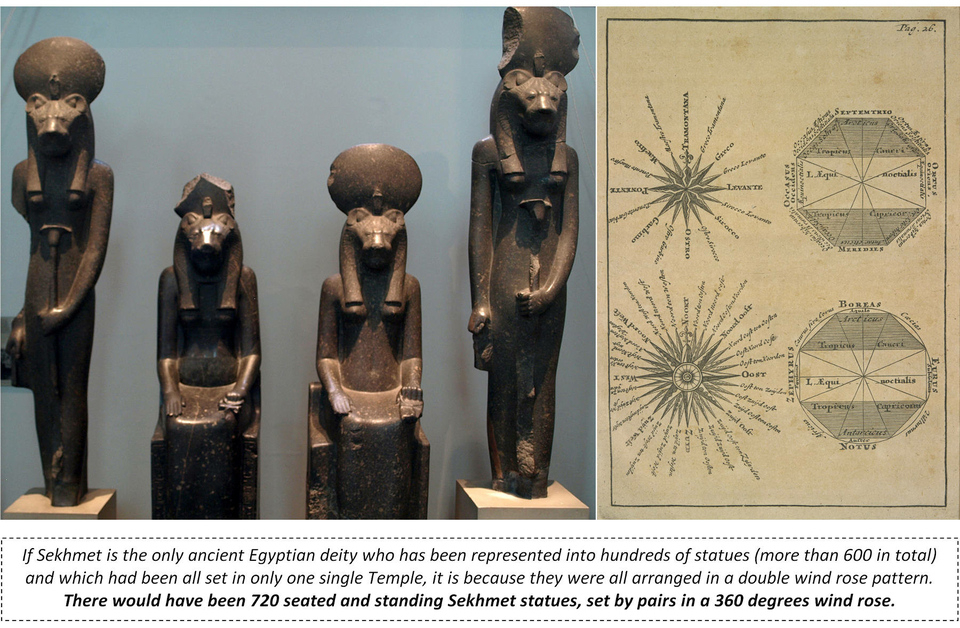
Four black granite statues of the goddess Sakhmet [=Sekhmet], all originally from Thebes, at the Temple of Mut. From the reign of Amenophis III, circa 1400 BCE: https://en.wikipedia.org/wiki/Sekhmet_statues#/media/File:FourStatuesOfGoddessSakhmet-FrontalView-BritishMuseum-August19-08.jpg Medieval wind rose: https://en.wikipedia.org/wiki/Wind_rose
47.07 When Sekhmet is both "unleashed upon earth" and presented as a protective guardian
We’ve already seen in Section 22, that Sekhmet was all about the powerful high winds of the desert because she is all about pressurized air; but now that we know she is actually just about the upper hatch which was operated just like a “French guillotine”, or a sluice gate; that there was a massive counterpoise constantly in perfect balance with the Serket hatch itself (Ma’at is the expression of the obsession of Egyptians for perfect balance), that the Sekhmet hatch was kind of a shield and that this shield was endlessly rising in the air before getting back laying onto the floor of the caisson with all its weight, many things from the following excerpts can be read with a whole new perspective:
"Sekhmet was the daughter of the sun god, Ra, and was among the more important of the goddesses who acted as the vengeful manifestation of Ra's power, the Eye of Ra. Sekhmet was said to breathe fire, and the hot winds of the desert were likened to her breath. She was also believed to cause plagues (which were called as her servants or messengers) although she was also called upon to ward off disease". https://en.wikipedia.org/wiki/Sekhmet
"The myths go on to state that whenever she breathed out, fire came out. Her breath was like the hot winds that blew from the desert. […] In one incident, it was believed that Ra had gotten frustrated with mankind’s insolence and transgressions against the principles of Ma’at. The sun god unleashed Sekhmet (The Destroyer of Rebellion) upon the earth in order to teach humanity a painful lesson. The myth goes on to say that Sekhmet killed every one of Ra’s conspirators, leaving the land of Egypt in a pool of blood. Such was her unquenchable thirst for blood that Ra feared she would kill every living soul in Egypt." https://www.worldhistoryedu.com/sekhmet-myth-and-powers/
47.08 The seated and standing statues of Sekhmet
The same way, the fact that hundreds of statues of Sekhmet had been discovered, either in a standing position or in a seated position, makes now perfectly sense: the Sekhmet hatch was indeed either in a raised position or in a seated position onto the floor of the central wooden wind pipe caisson.
"The origin of the Sekhmet statues was during the reign of Amenhotep III dynasty 18 (ca 1390-1352 BC). There have been more than six hundred statues that have been recovered from Egypt. Most of these Sekhmet statues were created under Amenhotep III. Sekhmet statues have been found at Amenhotep III Mortuary Temple/Complex at Kom el Heittan on the Theban West Bank and at the Temple of Mut at Karnak on the east bank of the Nile River at Thebes. Sekhmet statues can still be found and traced back to Amenhotep III. The Sekhmet statues are a part of his massive statuary program. Amenhotep III hoped that the Sekhmet statues would heal him from illness and bring him good fortune for the year. This is why there were so many Sekhmet statues being built and at such a fast pace. We can tell Amenhotep III favored the Sekhmet goddess since he used her statues so much for ritual practices. Many scholars believe that there were a total of 730 statues built which is two statues for everyday of the year." https://en.wikipedia.org/wiki/Sekhmet_statues
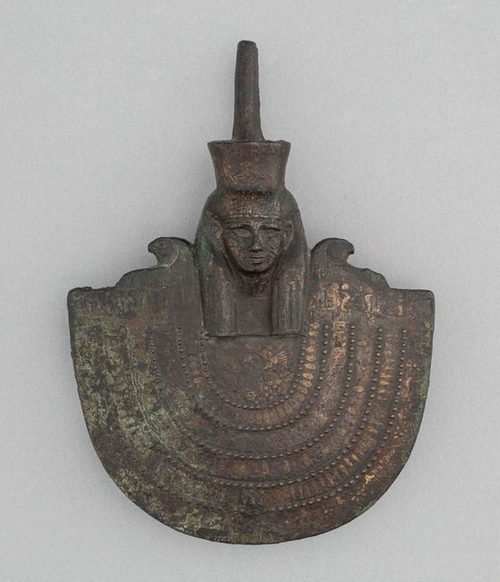
47.09 Neith also is about the “big step” and "big cut" at the upper end of the Gallery
If I actually had a sense for a very long time now that the curious shape of the Aegis and its counterpoise at a right angle from it, was all about the “big Step” at the top of the Grand Gallery; with the “big cut” in it, it is only when I started to dig into Neith that all started to take shape.
I could have been wrong about this intuition, but I followed the lead anyway: there had to be a very specific reason for a very few goddesses (like Isis, Hathor, Sekhmet and Neith) to have representations of their heads settled like this on top and in front of the “exaggerated broad collar” Aegis.
But at this point of the study, now that Sekhmet had been properly reassigned to the top end of the central wooden caisson, and that all these deities except Neith had already been deciphered; they all happen to share one common characteristic: they all represent the glorifications of what could have been located in the Gallery at some point at its top.
The conclusion is that Neith as well is about this very particular location in the Gallery. Neith is about the upper end of the Gallery, and there was a real chance that she was about the hatch.
The fact is that Neith is indeed about the hatch, but what is allowing us to say that doesn’t really come from Neith; it comes from the reinterpretation that Greeks had made of Neith: Athena.
Egyptian Aegis with the head of goddess Neith. Musée des Beaux-Arts de Lyon: https://collections.mba-lyon.fr/fr/notice/h-1550-neith-03343559-271d-4aac-babd-141fa95acb1a
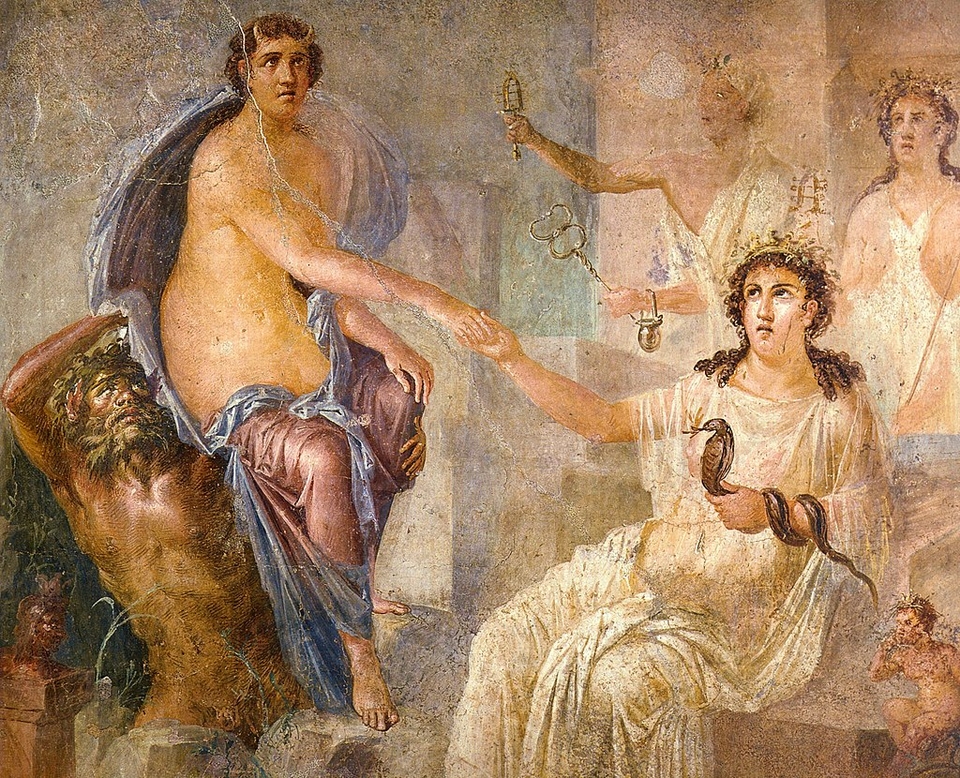
Greek goddess Io (on the left, with horns) is welcomed in Egypt by Isis (sitting, holding a snake and with a crocodile at her feet). Io is carried by a river god, setting her down at Kanopus near Alexandria. Roman fresco from the temple of Isis in Pompeii. Museo Archeologico Nazionale, (Naples). Inventory number 9558: en.wikipedia.org/wiki/Interpretatio_graeca#/media/File:Pompeii_-_Temple_of_Isis_-_Io_and_Isis_-_MAN.jpg
47.10 The “interpretatio graeca” isn’t just an “identification” of foreign deities with Greek deities but their total assimilation and reinterpretation from the very beginning: the process surely didn’t start with Herodotus
So, the intuition is that the Egyptian Aegis is about the upper end of the Grand Gallery, but Egyptians, like I’ve said many times, were very meticulous in their metaphoric representations and glorifications. Hopefully, other civilizations around them weren’t that meticulous and/or wanted to share more details of the true meaning of gods and goddesses. This time, the solution of the Aegis doesn’t come from Norse, Hindu, or Tibetan mythology, nor it doesn’t come from the umpteenth reinterpretation of the technological prowesses that have been made in the Jewish religion, it comes from the Greeks.
To be honest, I was apprehending to get to the Greek mythology, because the task now seems way too difficult for just one man. It’s almost like over 2,000 Egyptian gods and goddesses weren’t enough, right… now, I would need to study the entire Greek mythology; it’s both exiting and depressing.
But the important thing is that what I’ve described many times now, about how the ancient World has been so heavily influenced to the point that probably every civilization of that time, completely assimilated and reinterpreted the Egyptian deities to create their own myths, when it comes to Greeks, every historian agrees to that idea.
And that idea has a name: Interpretatio Graeca.
There is just one thing I disagree with. Historians are telling us that Greeks did two things:
• Greeks would have assimilated Egyptian deities to similar deities of their own
• Greeks would have imported brand new Egyptian deities and would have incorporated them in their mythology
But in my opinion, Greeks only did the second thing: they would have only reinterpreted the ancient Egyptian gods and goddesses, simply because the idea of having “similar” deities in Greece and in Egypt doesn’t make any sense to me and there only had to be original ones and copys.
It is said that Herodotus (fourth century Before Current Era) was the first one to engage into this kind of reinterpretation; but it is highly probable that it actually started centuries before that and that every single Greek deity is only a reinterpretation of an older ancient Egyptian deity.
“Interpretatio graeca (Latin, "Greek translation"), or "interpretation by means of Greek [models]", refers to the tendency of the ancient Greeks to identify foreign deities with their own gods. It is a discourse used to interpret or attempt to understand the mythology and religion of other cultures; a comparative methodology using ancient Greek religious concepts and practices, deities, and myths, equivalencies, and shared characteristics. The phrase may describe Greek efforts to explain others' beliefs and myths, as when Herodotus describes Egyptian religion in terms of perceived Greek analogues, or when Dionysius of Halicarnassus and Plutarch document Roman cults, temples, and practices under the names of equivalent Greek deities.”
“Herodotus [fourth century BCE] was one of the earliest authors to engage in this form of interpretation. In his observations regarding the Egyptians, he establishes Greco-Egyptian equivalents that endured into the Hellenistic era, including Amon/Zeus, Osiris/Dionysus, and Ptah/Hephaestus.”
https://en.wikipedia.org/wiki/Interpretatio_graeca
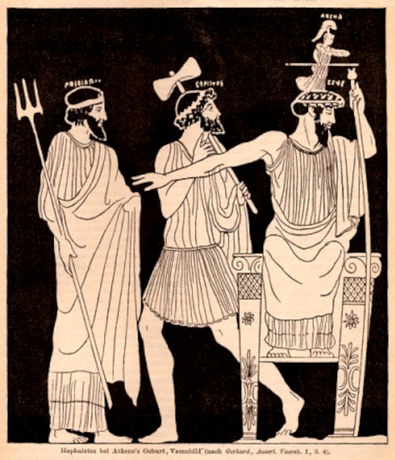
47.11 Athena is the Greek reinterpretation of Egyptian Neith: they are both the glorification of one same thing
The deciphering of the upper hatch of the central wooden caisson starts with Neith, or to be exact with her Greek reinterpretation: Athena. Of course, the assumption that “the Greeks identified Neith with Athena possibly as a result of the identification of both goddesses with war and weaving” is false: Greeks only copied Neith to create their own version of the Egyptian goddess.
But the more important is that Greeks, by doing so, only gave us more information about Neith, hence more information about how was operated the upper hatch of the Great Pyramid
“The Greek historian Herodotus (c. 484 – c. 425 BC) noted that the Egyptian citizens of Sais in Egypt worshipped Neith. The Greeks sought to draw a syncretic relationship to associate Egyptian deities with those of Greece. They identified Neith with Athena. The Timaeus, a dialogue written by Plato, mirrors that identification with Athena, possibly as a result of the identification of both goddesses with war and weaving.” https://en.wikipedia.org/wiki/Neith
Birth of Athena from the head of Zeus, from a vase painting: wikipedia/commons/8/87/Birth_of_Athena.jpg
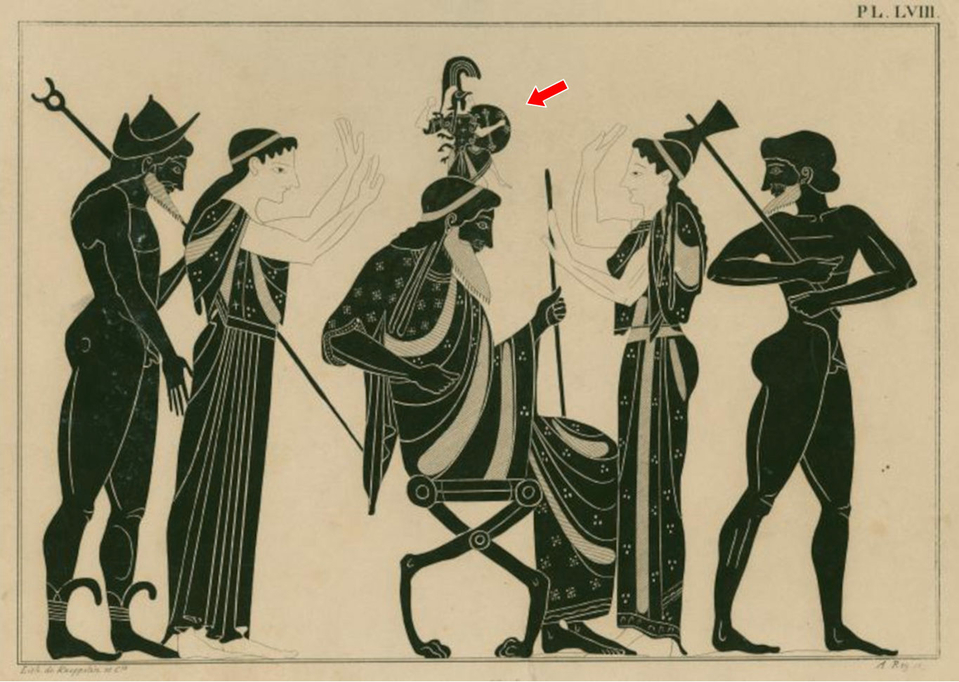
Zeus gives birth to Athena. The Miriam and Ira D. Wallach Division of Art, Prints and Photographs: Picture Collection, The New York Public Library. New York Public Library Digital Collections. Accessed March 16, 2024: https://digitalcollections.nypl.org/items/510d47e4-1a12-a3d9-e040-e00a18064a99
47.12 Athena and Zeus carried the Aegis “device” and it was all about “violent windstorm” and a “shield”
This is it. The Aegis led us to Neith, then to Athena and now we have the whole story: the story where both Athena and Zeus are holding some kind of “shield” associated with “violent windstorms” that are producing a sound “like myriad roaring dragons” and also associated with some kind of “goatskin coat”.
And all that is about the upper hatch of the central wooden caisson… because the Aegis, this device, this “shield” is the hatch itself and its only goal was to maintain pressurized air inside the caisson. The hatch was designed to keep the “violent storms” inside the caisson.
“The aegis, as stated in the Iliad, is a device carried by Athena and Zeus, variously interpreted as an animal skin or a shield and sometimes featuring the head of a Gorgon. […] The modern concept of doing something "under someone's aegis" means doing something under the protection of a powerful, knowledgeable, or benevolent source. The word aegis is identified with protection by a strong force with its roots in Greek mythology and adopted by the Romans; there are parallels in Norse mythology and in Egyptian mythology as well, where the Greek word aegis is applied by extension.
The Greek αἰγίς aigis has many meanings, including:
• "violent windstorm", from the verb ἀίσσω aïssō (word stem ἀιγ- aïg-) = "I rush or move violently". Akin to καταιγίς kataigis, "thunderstorm".
• The shield of a deity as described above.
• "goatskin coat", from treating the word as meaning "something grammatically feminine pertaining to goat": Greek αἴξ aix (stem αἰγ- aig-) = "goat" + suffix -ίς -is (stem -ίδ- -id-).
“The original meaning may have been the first, and Ζεὺς Αἰγίοχος Zeus Aigiokhos = "Zeus who holds the aegis" may have originally meant "Sky/Heaven, who holds the thunderstorm". The transition to the meaning "shield" or "goatskin" may have come by folk etymology among a people familiar with draping an animal skin over the left arm as a shield.
“The aegis of Athena is referred to in several places in the Iliad. "It produced a sound as from myriad roaring dragons (Iliad, 4.17) and was borne by Athena in battle ... and among them went bright-eyed Athene, holding the precious aegis which is ageless and immortal: a hundred tassels of pure gold hang fluttering from it, tight-woven each of them, and each the worth of a hundred oxen."
“According to Edith Hamilton's Mythology: Timeless Tales of Gods and Heroes, the Aegis is the breastplate of Zeus”. https://en.wikipedia.org/wiki/Aegis
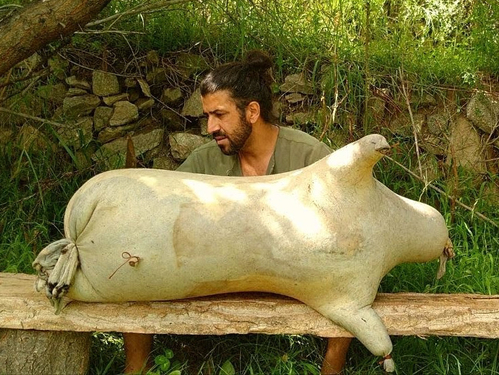
47.13 The endless pounding of the upper hatch and the churning the milk metaphor
When it is said that the meaning of the Aegis could be about a goatskin coat, it is also correct: the metaphor is here about a “tarig”, the goat skin used in some countries to churn the milk and produce butter. One very accurate way of describing the endless up and down movement of pounding of the upper Sekhmet hatch is indeed the churning process of milk.
And there is probably another mea culpa here: we’ve seen in Section 37 that Hindus had reinterpreted the ancient Egyptian deities just like the Greeks, and that their founding myth was “the churning of the Ocean of Milk”, and I first thought that this mention of “churning water” was a reference to the endless movement of the impactor into the waters of the inclined well… but of course now, it is difficult to say if it is true or not; maybe the Hindu myth is not about the impactor, but about the upper hatch instead.
Image from a video filmed by Salamat, "Traditional way to prepare goat skin for water bag and butter making". https://www.youtube.com/watch?v=UnaLCTA8uMk
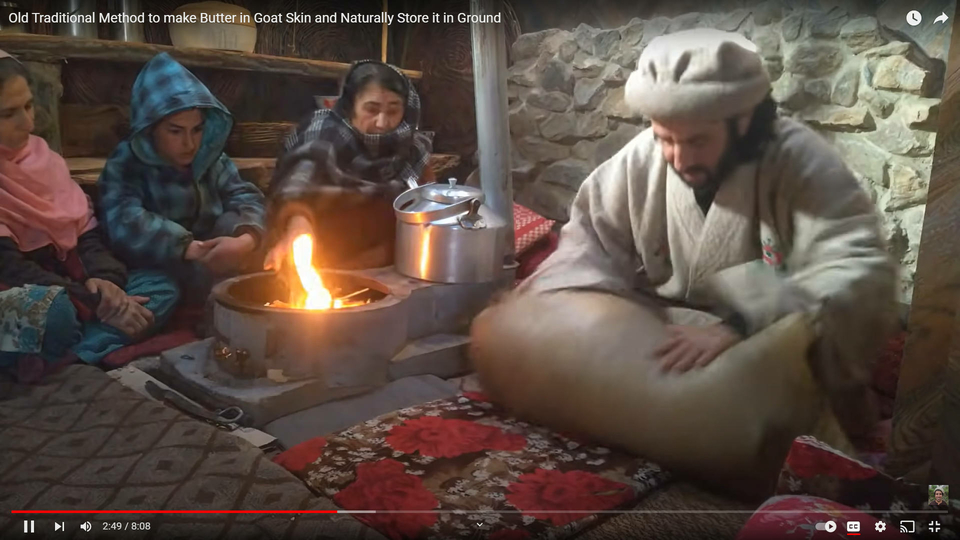
“Make Butter in Goat skin, an old traditional method to make butter and naturally store in ground for many years. We made butter in goat skin called in Burushaki Taring, then we packed it in birch paper and stored in ground near a water channel. Butter can be stored in moist ground near water running channel for long period many years. The naturally stored old butter in ground has many health benefits.” An extraordinary video, by Salamat (mountains of northern Pakistan): https://www.youtube.com/watch?v=1NaGAQM-VQE
47.14 First method of churning milk to make butter: the goat skin
In the second video of Salamat (link below), there is probably many crucial things that explain the goatskin coat metaphor, if you have a few minutes ahead of you, this is one of very few videos I found inspiring.
If you want to have a “taste” of how ancient Egyptians lived and used their “ordinary” life as the support for all these metaphors we’ve seen so far, this video is for you. In particular you’ll see that to make butter with the skin goat, you have to pour water in the vessel, you have to blow air in the vessel, and then you have to store the butter in the ground newt to water so that the earth keeps moist at all times.
“Locally know as Tarig, the goat skin had been used for centuries to churn the milk and carry as water bag.”
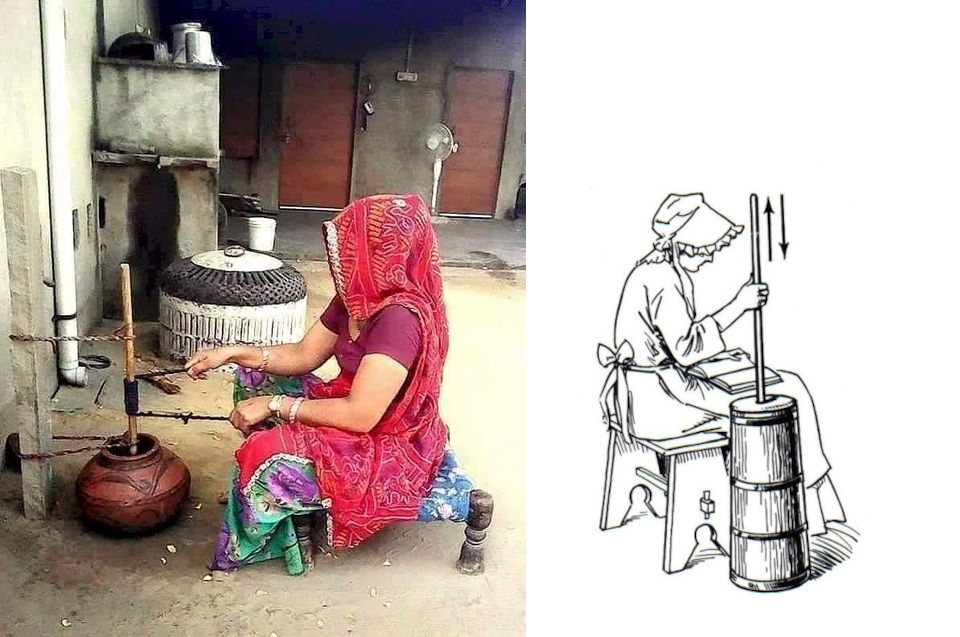
Second method for churning milk: the rotating tool. Monika Marwadi (Rajasthan, northern Beautiful India): https://www.facebook.com/photo/?fbid=694468967663226&set=a.444355992674526
Third method for churning milk: the pounding tool. “Line art drawing of a churn”, by Pearson Scott Foresman: https://commons.wikimedia.org/wiki/File:Churn_(PSF).jpg
47.15 The second method of churning milk to make butter: the rotating tool
In this method, this is the endless rotating movement of the operating axle of the hatch that is pointed out.

Operation of the Grand Gallery of the Great Pyramid of Giza. The impactor is locked and secure by the Sekhmet upper wooden hatch, ready to be released. The hatch is always in perfect balance with its counterpoise (that is what Ma'at is all about). On this draw two kinds of glorifications have been used: the original ancient Egyptian deities (like Ra, Osiris, Isis, Neith, Sekhmet…) and some of their Greek reinterpretations (like Athena for Neith, or the “Shield of Athena” for the upper hatch Sekhmet). Last updated April 5, 2024.
47.16 If Athena is born from “the forehead” of Zeus, then Zeus is about the central wooden caisson
If the shield of Athena and Zeus is about the hatch, then the question is to know exactly what Athena and Zeus are really referring to. Most probably, the part of the myth describing “the birth of Athena” from the forehead of Zeus is the clue.
Remember that both Athena and Zeus are holding the shield, and there was only two elements in the Pyramid which really were holding the hatch: the central wooden caisson (probably the hatch was moving up and down into some grooves), and the ropes (there would have been probably two ropes) which would have make the hatch move.
But if Athena is said to be born from the “forehead” of Zeus (this is Athena getting out of Zeus), and Metis being swallowed by Zeus (this is Metis getting in Zeus), then it means that:
• Zeus is the central wooden wind pipe caisson
• Athena is about the driving ropes lifting the hatch up out of the caisson
• Metis is about these same ropes but lowering the hatch down into the caisson
“In Greek mythology, Athena was believed to have been born from the forehead of her father Zeus. In some versions of the story, Athena has no mother and is born from Zeus' forehead by parthenogenesis. In others, such as Hesiod's Theogony, Zeus swallows his consort Metis, who was pregnant with Athena; in this version, Athena is first born within Zeus and then escapes from his body through his forehead.” https://en.wikipedia.org/wiki/Athena
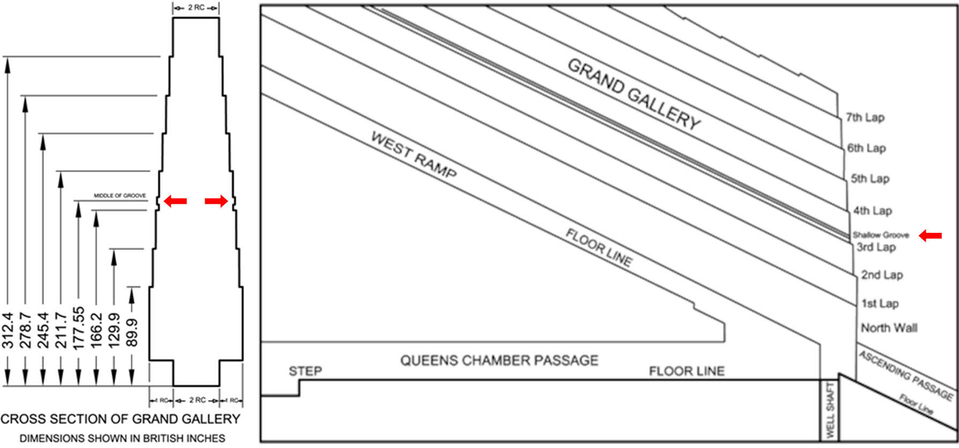
The grooves on both walls of the Grand Gallery, at 4.5 meters high could have been designed to accommodate a guiding system for the ropes operating the upper hatch: thegreatpyramidofgiza.ca/content/index.html
47.17 The shallow grooves of the Grand Gallery (4.5 meters high)
To this day, there was nothing of the design of the Grand Gallery I’ve already discussed that would have explained the famous shallow grooves standing at about 4.5 meters high (177.55 British inches) on both walls of the Gallery. But now that we know there was the operating structure of the upper hatch that would need some guiding support at its top, it could be the beginning of the answer.
Because, maybe the operation of the hatch was made from the bottom of the Gallery by the crewmembers of the hauling Beetle, and some sort of guiding system for the operating ropes of the hatch would have been necessary.
“the grooves are scarcely suitable for the insertion of large boards - it is more likely that they were constructed to lodge a cross beam, which can be inserted deeply, a transverse beam can be part of a movable structure to lift up heavy objects by means of ropes; it can be interlocked by a vertical board that is fixed at the centre of the floor by two side planks. The continuity of the grooves along the walls would allow to move easily such simple device from the north part of the gallery to its upper end.” Luca Miatello in PalArch’s Journal of Archaeology of Egypt/Egyptology 7 (6) (2010). Examining the Grand Gallery in the Pyramid of Khufu and its features. At Digital Giza, Harvard University: http://giza.fas.harvard.edu/pubdocs/972/full/
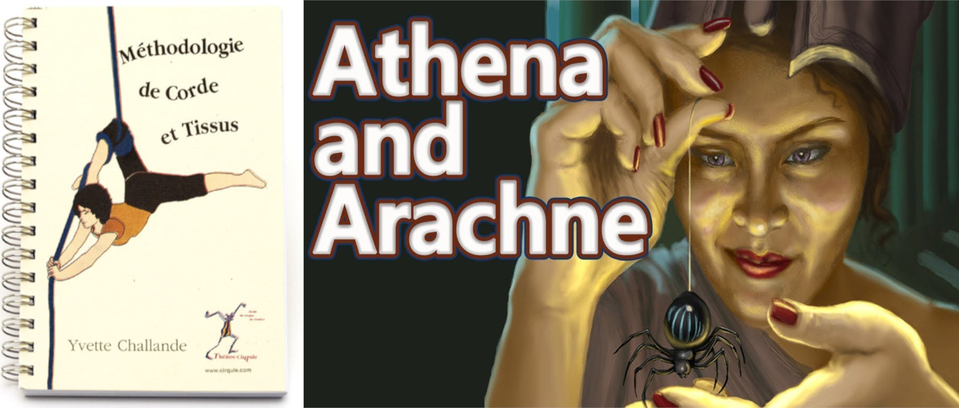
Rope and Aerial Silk Methodology Book, by Yvette Challande: https://www.jonglerie.com/en_US/shop/1905-book-methodology-of-rope-and-fabric-200p-only-in-french-3984?category=284#attr=
"Athena and Arachne", Greek Mythology Ep.21. See U in History: youtube.com/watch?v=UoMJm-Les6Q
47.18 Athena and Arachne weren't fighting but balancing each other
I know I’ve already said that many times, but this metaphor about Athena (the Greek reinterpretation of the driving ropes which lifted the upper hatch of the central wooden wind pipe caisson of the Great Pyramid), having a weaving contest with Arachne who will transform herself into a spider, is definitely one of the cutest metaphors of all.
Keep in mind that because the upper hatch had to be a full internal hatch it had to be big and heavy. The consequence is that it could only have been operated through a relatively massive and big wooden structure that would have elevated high in the Grand Gallery: in order to operate the hatch, and as so elegantly suggested by the design of the Aegis itself (the Aegis is always associated with its own counterpoise), the wooden hatch had to be associated with its own counterpoise.
In other words, both the wooden hatch and its stone counterpoise with their ropes would have looked like two spiders hanging down from threads of their web. Of course it also echoes to the fact that Neith’s emblem is a weaving shuttle.
In short, Athena and Arachne weren’t fighting against each other: they were actually the image of each other; a weight and a counterweight perpetually balancing each other.
“Arachne, lit. 'spider', cognate with Latin araneus) is the protagonist of a tale in Greek mythology known primarily from the version told by the Roman poet Ovid (43 BCE–17 CE), which is the earliest extant source for the story. In Book Six of his epic poem Metamorphoses, Ovid recounts how the talented mortal Arachne challenged the goddess Athena to a weaving contest. When Athena could find no flaws in the tapestry Arachne had woven for the contest, the goddess became enraged and beat the girl with her shuttle. After Arachne hanged herself out of shame, she was transformed into a spider.” https://en.wikipedia.org/wiki/Arachne
“Silk production differs in an important aspect from that of most other fibrous biomaterials. It is pulled on demand from a precursor out of specialised glands, rather than continuously grown like plant cell walls. The spinning process occurs when a fibre is pulled away from the body of a spider, whether by the spider's legs, by the spider's falling under its own weight, or by any other method. The term "spinning" is misleading because no rotation occurs. It comes from analogy to the textile spinning wheels.” https://en.wikipedia.org/wiki/Spider_silk
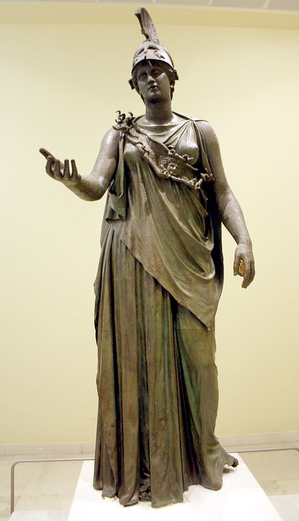
47.19 If Athena is so often associated with bronze… it is only because she was the glorification of chains, and these chains were made of bronze
First I thought that the Sekhmet/Metis upper hatch was operated by ropes just like the four ropes of the Gallery, but I couldn’t make everything work properly: there were too many disruptive pieces that didn’t fit either Neith, Athena or both of them at the same time. And then it struck me: Athena is not about ropes, but about chains and they were made of bronze.
1 • Athena’s temple was entirely decorated with plaques made of bronze
2 • Athena’s cult statue in Athens was made of bronze
3 • Athena was associated with bronze bells
4 • Athena was pictured on the Athenian tetradrachm coins mostly made of bronze
5 • Athena is associated with [rattling] noise because chains make noise
6 • Athena’s Eyes are gleaming and green because bronze material oxidizes over time
“In Sparta, Athena has the local epithet Chalkioikos, ‘of the bronze house’. The walls of Athena’s temple at the Spartan akropolis were decorated with bronze plaques [1], and her cult statue was made of bronze [2]. It points to Athena’s Spartan patronage of bronze metalworkers. What I find more intriguing about Athena’s worship in Sparta is the use of bells: “Forty bronze and 80 terracotta bells have been excavated here [3], unique to Sparta. Bells are ornamental and musical, used to sound the hours, for subservient functions, to call communities together, and to commemorate important events and people. But we don’t know how the Spartans used them. Classical scholar Susan Deacy suggests that the bells were apotropaic and rung to ward off evil, related to Athena’s protective role. Deacy adds that Athena is associated with the creation of noise [5], noting the war cry at her birth and her invention of the aulos, a wind instrument.” https://cosettepaneque.com/epithets-of-athena/
Illustration: the Piraeus Athena is a bronze statue dated to the fourth century BCE. It currently resides in the Archaeological Museum of Piraeus (Athens). The work has been given to either Kephisodotos or Euphranor (4th century B.C.), or deemed to be a Hellenistic-era creation in classicizing style. Picture by Giovanni Dall'Orto, November 14 2009. https://en.wikipedia.org/wiki/Piraeus_Athena
47.20 The colossal “Great Bronze Athena”
The cult statue of Athena, made of bronze, is of course the colossal statue known as the Athena Promachos, and she was known as the "Great Bronze Athena"... indeed she was.
“The Athena Promachos, "Athena who fights in the front line", was a colossal bronze statue of Athena sculpted by Pheidias, which stood between the Propylaea and the Parthenon on the Acropolis of Athens. […] Made entirely of bronze, the Athena Promachos was spoken of as both 'the bronze Athena' and 'the great bronze Athena,' in ancient times.”
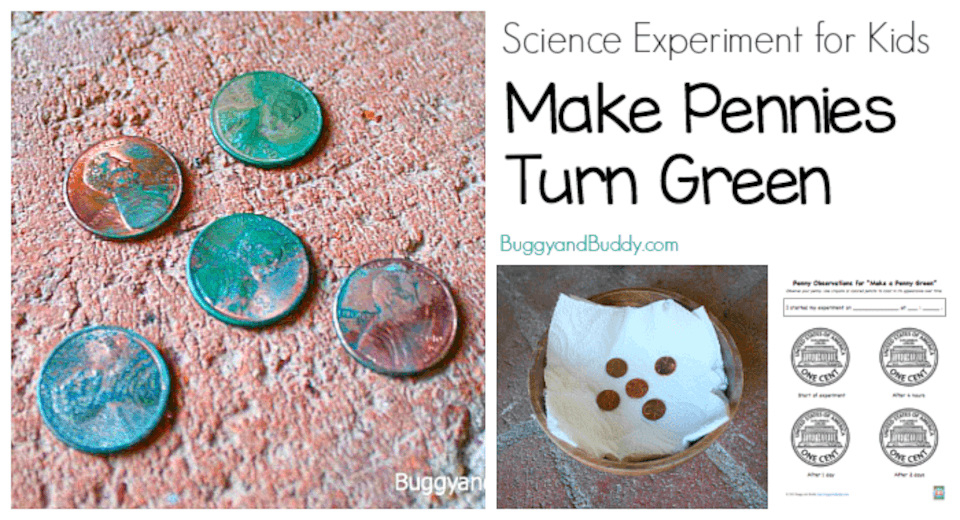
Chemical Reactions: Make a Penny Turn Green (with free printable). Chemical reactions are always surprising for kids to observe! In this science activity we’ll be turning a penny green (similar to what happens to The Statue of Liberty!): https://buggyandbuddy.com/science-for-kids-make-a-penny-turn-green/
47.21 The metaphor of the Eyes of Athena and bronze coins
“Athena has several epithets relating to her eyes: Glaukopis, Ophthalmitis, and Oxyderkous. Scholars variously translate Glaukopis as ‘bright-eyed’, ‘with gleaming eyes’ [6], ‘darting-eyed’, and ‘owl-eyed’. Athena is sometimes described as ‘grey-eyed’, but the word combination can also mean ‘silvery’, ‘blue-eyed’, or ‘green-eyed’ [6]. The point is not the colour of Athena’s eyes but that they blaze forth light [6]. This dazzling brightness is a feature of her epiphanies. In his Description of Greece, traveller and geographer Pausanias described a place in Sparta called Theomelida where the temple of Athena Ophthalmitis, Athena of the Eyes, stood.” https://cosettepaneque.com/epithets-of-athena/
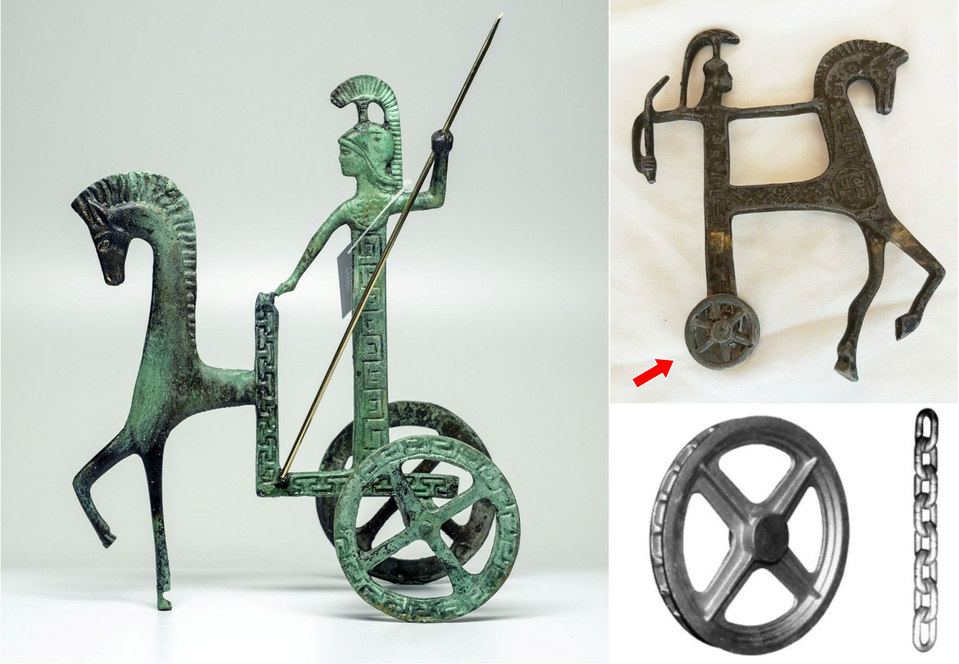
“Athena on her Chariot” at Greek Artifact Store: https://greek-artifact-store.gr/product/athena-on-her-chariot-handmade-oxidized-bronze-statue-21cmx17-8-26-x6-69-tall/ and https://www.ebay.co.uk/itm/314944863494
Chain and hand chain wheel made of cast iron: https://www.cah-heiderich.de/en/our-product-groups/blocks-and-rope-accessories-for-hardware-retailers/manually-operated-chain-wheels-and-trolleys/hand-chain-wheels-made-of-cast-iron.html
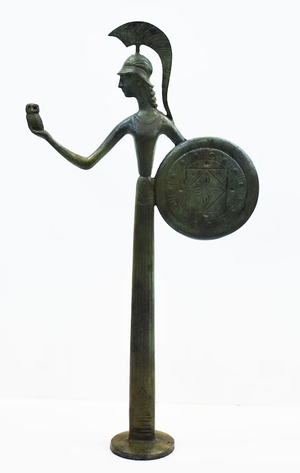
47.22 The chain wheels supporting Athena on her "chariot"
There are many representations of Athena standing on a chariot, and on these representations, she is supposed to be engaged in some kind of military action; she is indeed a goddess of war, but it doesn’t seem that her appearance and her posture seem to bother anybody, even if she appears thin as a straw and in a perfectly straight and vertical upright posture. Honestly, it doesn’t make any sense.
The thing is that the famous chariot is actually only a decoy. The only purpose of these chariots are to represent Athena (the chains in bronze) with the two wheels which supported the chains in the Grand Gallery: the wheels of the chariot are actually the chain wheels (Neith/Athena) operating the upper hatch.
And most of the time, the chariot on which Athena is standing is really trying to appear like a real chariot, but if you take a good look at the one represented on the upper right side of the above image, the artist didn’t even try to do so and you really have the straight and upright Athena directly connected to the wheels… the chain wheels.
Helmeted Goddess Athena with her Owl and Shield-Bronze Statue-Patron of Athens-Symbol of Wisdom: https://www.etsy.com/ca/listing/1265364938/helmeted-goddess-athena-with-her-owl-and
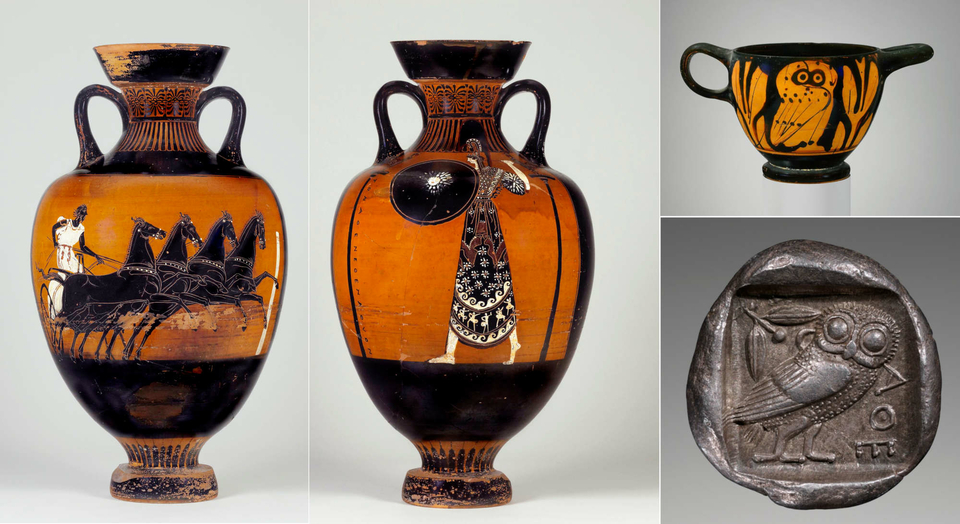
Pottery Panathenaic amphora, prize money, at the British Museum showing a chariot race (left) and Athena (right): https://www.britishmuseum.org/collection/object/G_1866-0415-249
47.23 Olive oil was the “substance of the gods” because it was used as a lubricant in the Great Pyramid
And now, there is my favorite part of this Section, because when you are dealing with chains and some kind of ancient crane, there is one very important and mandatory measure to take, and that is of course lubrication.
Nothing seems to have survived “officially” about lubrication in ancient Egypt, and there probably are some deities which were about it using other metaphors that I didn’t have the chance to see and/or understand at that time; but there are many illustrations of this lubrication process that have been made by ancient Greeks, and that is what the olive oil is all about: if Athena’s emblem is officially the olive tree it really is because of the olive oil used as a lubricant for Athena herself.
In the following excerpt, the most interesting part is at the very end, when it is stated that the most important events during the Panathenaic Games were the chariot races and that the prize consisted of olive oil.
Of course the olive oil had a great value; it was worth a lot of money and very useful for cooking and some other uses, but the olive oil as a prize of the Panathenaic Games also had a very important metaphorical value: you certainly cannot win the chariot races if you didn’t lubricate the gears of the chariot.
And we’ve already seen the profound meaning of the chariots: they were metaphorical representations of some kind of pulleys which supported the chains operating the upper hatch. Chariots are all about these pulleys, or “chain wheels”, and they had to be properly lubricated.
And this is why Athena is so often represented completely “surrounded” by olive tree branches: the idea is to “immerge” Athena (the chains) into the olive oil.
And this is only because olive oil has been used as a lubricant for the chains used in the Grand Gallery, that olive oil has been considered as the “substance of the gods”
“Olive oil was a prize at the Panathenaic Games: the ancient Greeks used amphorae to store olive oil for games. A men’s 200m sprint winner received a variable amount of around 100 liters of olive oil in his prize amphora. Olive oil was sold for twelve drachmas per 45-liter jar. Winners would receive a prize that included money, gold crowns, shields, olive oil, bulls, or wine. The prize amphorae were the symbol of Athenian society, a Panhellenic festival that celebrated the god Athena. The first Panathenaia was organized by Pisistrato in 566 BC. In addition to athletic competitions, there were music and poetry competitions. The games were categorized for Athenians and others. The games themselves were divided into three age categories and included various challenges. The chariot races were considered the most important events. The prize consisted of olive oil. […] The first written history of the use of olive oil as a lubricant dates back to 350 BC. Aristotle wrote about the lubricating properties of olive oil. The Greeks switched to olive oil as their preferred lubricant, as olive oil was considered the substance of the gods.” https://www.marchesigallo.it/olive-oil-and-the-ancient-greeks/?lang=en

47.24 “Athena of the Eye” and… olive oil used as eye health treatment
Athena is all about gleaming Eyes… the Owl of Athena is all about Eyes as well… and of course there is a very direct link with olive oil, because olive oil has been used for generations for eye health. And that is probably the reason why the big Eye cups decorated with the figure of Athena were so big you could put your entire face inside the cup. But did Greeks really used the bowls for eye baths with some olive oil in the bath or did they used the bowls to prepare ointments with olive oil used for treatments for eye infections?
“The curative powers of olive oil were already known in Ancient Egypt. The Ebers Papyrus is a medical text dating back to around 1,550 BCE. It contains recipes and remedies for various ailments, many of which involve the use of oils and ointments made from plants and other natural materials, including olive oil. There are recipes for ointments made with olive oil to treat skin conditions such as eczema and psoriasis, as well as to soothe insect bites and stings. It is also mentioned as a treatment for joint pain and eye infections”. From antiquity to contemporary times: how olive oil by-products and waste water can contribute to health, by Adriana Albini, National Library of Medicine: https://www.ncbi.nlm.nih.gov/pmc/articles/PMC10615083/
“To fully embrace the eye health benefits of olive oil, incorporate it into your daily routine. Drizzle it over your favorite dishes or use it in recipes calling for olive oil. For a touch of luxury, gently apply it around your eyes before bedtime, and let it work its magic as a natural eye cream while you sleep.” Jared Melkun at https://taycte.com/blogs/resources/the-eye-health-benefits-of-olive-oil
“Extra virgin olive oil (EVOO) has been well researched for its antioxidant properties for maintaining good health. Spanish researchers from the University of Jaén have found a way to add yet another antioxidant especially beneficial for good eye health, to extra virgin olive oil. Lutein is a carotenoid found in green leafy vegetables. In fact, lutein and zeaxanthin are found in the retina and macula of the eye. Research has shown that lutein may help to prevent or reduce the severity of age-related macular degeneration (AMD) of the eyes. AMD is a disease that mainly effects seniors, as aging is the main risk for developing it. AMD causes a deterioration of the macula which is found in the retina of the eye.” Extra Virgin Olive Oil and Lutein for Eye Health, by Chelsey Van Duyn, Center for Rehabilitation & Nursing: vanduyncenter.com/extra-virgin-olive-oil-and-lutein-for-eye-health/
Illustration of benefits of olive oil for eye health: https://www.stefanandsons.com/the-surprising-benefits-of-olive-oil-for-eye-health/
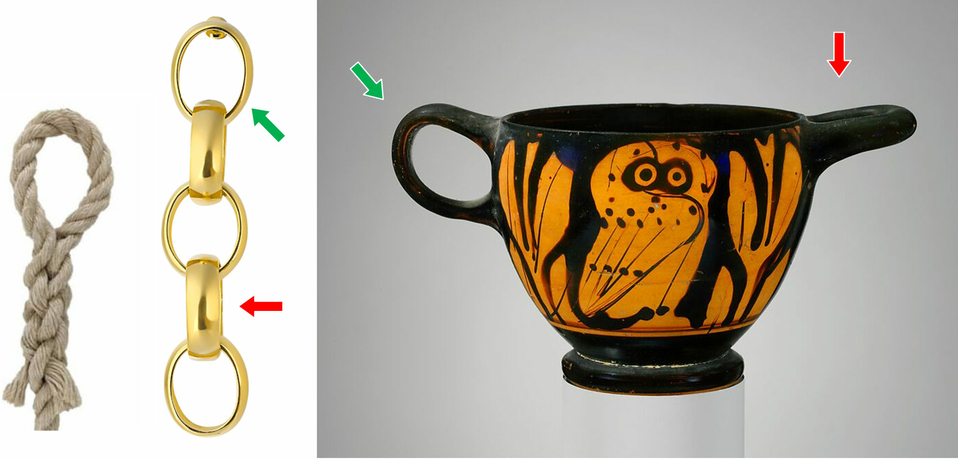
The Owl of Athena on a terracotta skyphos (deep drinking cup), Greek, Attic, mid-5th century BCE. On view at The Met Fifth Avenue in Gallery 171. Obverse and reverse, owl between olive sprigs. This work represents a type of skyphos in which one handle is vertical and the other horizontal. Because an owl is frequently the decoration, the shape is known as a glaux, the Greek word for owl Metropolitan Museum of Art, New-York: metmuseum.org/art/collection/search/254299
47.25 The Owl of Athena and the handles at a 90° angle of the Eye cups are indeed about Eyes
The most surprising thing about these Feast of Lamps festival, is that these lamps would most probably be the exact same thing as the above illustration of string lights: just like the chains were above the ground in the Grand Gallery, the lamps would have been above the ground as well.
And there is one very important emblem of Athena (remember Neith = Athena) which is supporting this idea: the Owl of Athena.
“Athena has several epithets relating to her eyes: Glaukopis, Ophthalmitis, and Oxyderkous. Scholars variously translate Glaukopis as ‘bright-eyed’, ‘with gleaming eyes’, ‘darting-eyed’, and ‘owl-eyed’. Athena is sometimes described as ‘grey-eyed’, but the word combination can also mean ‘silvery’, ‘blue-eyed’, or ‘green-eyed’. The point is not the colour of Athena’s eyes but that they blaze forth light. This dazzling brightness is a feature of her epiphanies.
In his Description of Greece, traveller and geographer Pausanias described a place in Sparta called Theomelida where the temple of Athena Ophthalmitis, Athena of the Eyes, stood. “They say that it was dedicated by Lycurgus when Alcander knocked out one of his eyes because he happened not to like the laws which Lycurgus made. Lycurgus escaped to this place, and the Lacedaemonians saved him from losing the other eye also. So he built a temple of Athena Ophthalmitis.”
At her sanctuary in Argos, she was known as Athena Oxyderkous, which is translated as “sharp-sighted’, ‘with penetrating gaze’, and ‘clear-sighted’. The Trojan hero Diomedes, a favourite of Athena’s, founded the sanctuary in gratitude for the goddess “lifting the mist from his eyes” during battle.” By Cosette at https://cosettepaneque.com/epithets-of-athena/
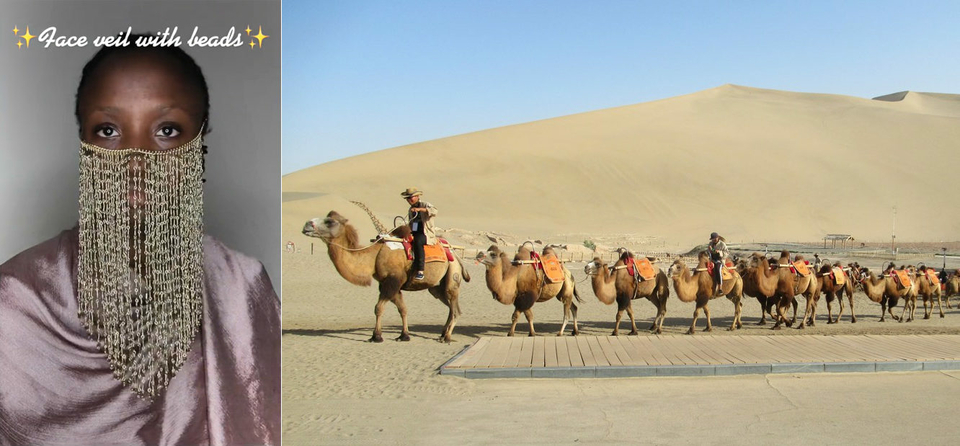
Chain face veil: Beads by Biodun at https://www.tiktok.com/@beadsbybiodun/video/7150758671125843206
Bactrian Camel Chain. Tourists are carried up into the Mingsha Sand Dunes just south of Dunhuang, China, on Bactrian camels such as these. Photograph by David Stanley: flickr.com/photos/davidstanleytravel/28435151728
47.26 Egyptian goddess Neith and the multiple chain metaphors
Now that we know that Athena isn't about ropes but chains, and that they were made of bronze (essentially copper), many epithets given to Neith (Neith/Athena) can be beautifully explained:
1 • The fact that in a chain (or chain link "Eye") there is no beginning nor there is no end
2 • The fact that face veils can be made of chains
3 • The fact that camels are travelling forming chains
4 • The fact that you can weave chain maille
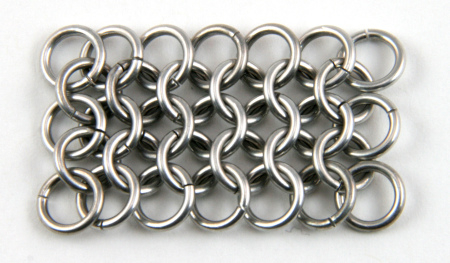
“The inscription on Neith’s temple in Sais in the Nile Delta (now modern Sa el-Hagar) read: “I am all that has been, that is and that will be [1]. No mortal has yet been able to lift the veil that covers me [2]. Neith, the First One, primordial goddess, was never born but always existed [1]. Alternatively she is completely self-generated. Neith travelled from the deserts and oases of Libya [3] to emerge as among the greatest of Egyptian goddesses. In one Egyptian creation myth, Neith brought forth Ra, the sun. Then she invented the shuttle and loom [4], put the sky on her loom, and wove the world into existence. Neith, the first to give birth, invented weaving [4]. Her name may derive from a word for “to weave” or “to knit.”. https://occult-world.com/neith/
Small European 4 in 1 Sheet Sample. The most commonly recognized chain maille weave. “Chain maille is an art of armor making that is thousands of years old, and is created by interlocking individual metal rings into one of many different “weaves”, or patterns. No one knows, or can agree on, exactly how old chain maille really is.” https://metalandmineral.wordpress.com/2011/10/15/chain-maille-basics/
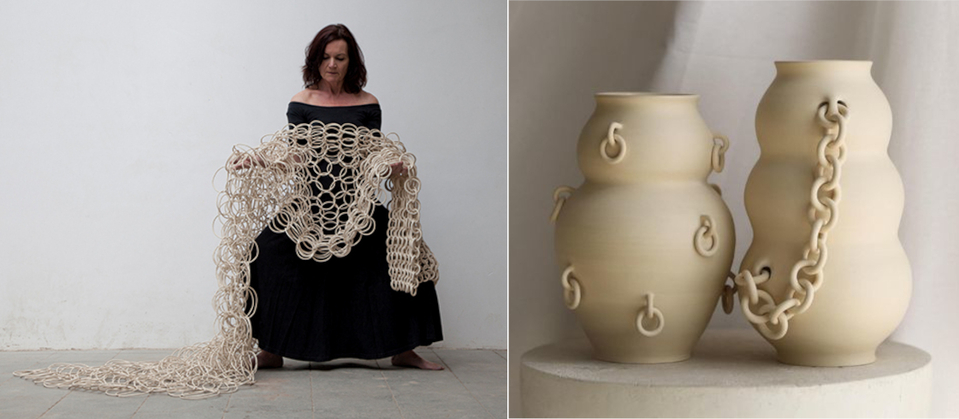
The ceramist artist Cecil Kemperink with one of her sculptures. Woman Create, photographed by Marja Sterck: https://womencreate.com/what/cecil-kemperink/?doing_wp_cron=1711974191.4288709163665771484375
Handcrafted ceramic art inspired by the natural and ancient elements of our world, by ceramist artist Kelsey Floyd: https://www.facebook.com/mymusepottery/
47.27 Athena goddess of pottery, art and sculptures because she is about chains... made of many Eyes
The epithet "Athena of the Eyes" is of course because of the individual chain links that look like eyes.
“Athena has several epithets relating to her eyes: Glaukopis, Ophthalmitis, and Oxyderkous. Scholars variously translate Glaukopis as ‘bright-eyed’, ‘with gleaming eyes’, ‘darting-eyed’, and ‘owl-eyed’. Athena is sometimes described as ‘grey-eyed’, but the word combination can also mean ‘silvery’, ‘blue-eyed’, or ‘green-eyed’. The point is not the colour of Athena’s eyes but that they blaze forth light. This dazzling brightness is a feature of her epiphanies.
In his Description of Greece, traveller and geographer Pausanias described a place in Sparta called Theomelida where the temple of Athena Ophthalmitis, Athena of the Eyes, stood. “They say that it was dedicated by Lycurgus when Alcander knocked out one of his eyes because he happened not to like the laws which Lycurgus made. Lycurgus escaped to this place, and the Lacedaemonians saved him from losing the other eye also. So he built a temple of Athena Ophthalmitis.”
At her sanctuary in Argos, she was known as Athena Oxyderkous, which is translated as “sharp-sighted’, ‘with penetrating gaze’, and ‘clear-sighted’. The Trojan hero Diomedes, a favourite of Athena’s, founded the sanctuary in gratitude for the goddess “lifting the mist from his eyes” during battle.” By Cosette at https://cosettepaneque.com/epithets-of-athena/
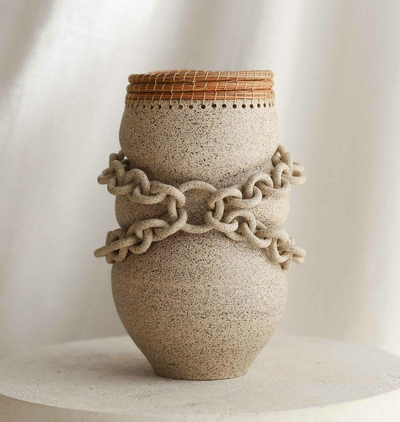
47.28 Additionally to being the goddess of weaving and pottery, Athena was also "the Subduer of the winds”
Athena had many epithets that didn’t seem to have anything in common:
• Athena was the goddess of towns
• Athena was the goddess of weaving
• Athena was the goddess of pottery and sculpture
• Athena was known as “the Subduer of the winds”
It could seem very hard to make sense of all these epithets, but when you know that Athena is about the rope operating the upper hatch, some kind of sluice gate, then it all makes sense: the protection of towns (the protecting gate), the weaving (the endlessly moving upside down hatch), and the sculpture and pottery thing (the rope pottery).
Of course, the fact that Athena (Athena/Neith) was known as the “Subduer of the winds” is priceless, because it was precisely Athena’s role (the rope) to lower down the hatch that will keep pressurizes air inside the caisson.
“Athena was the Olympian goddess of the defense of towns and the crafts of weaving, pottery and sculpture.”
“Anemotis (Anemôtis), the subduer of the winds, a surname of Athena under which she was worshipped and had a temple at Mothone in Messenia. It was believed to have been built by Diomedes, because in consequence of his prayers the goddess had subdued the storms which did injury to the country.”
https://www.theoi.com/Cult/AthenaTitles.html
Another beautiful pottery by Kelsey Floyd which is perfectly illustrating the posture of the four “goddesses” Isis, Nephthys, Neith and Serket on the shrine of Tutankhamun. Pottery at https://kelseyfloydpottery.com/
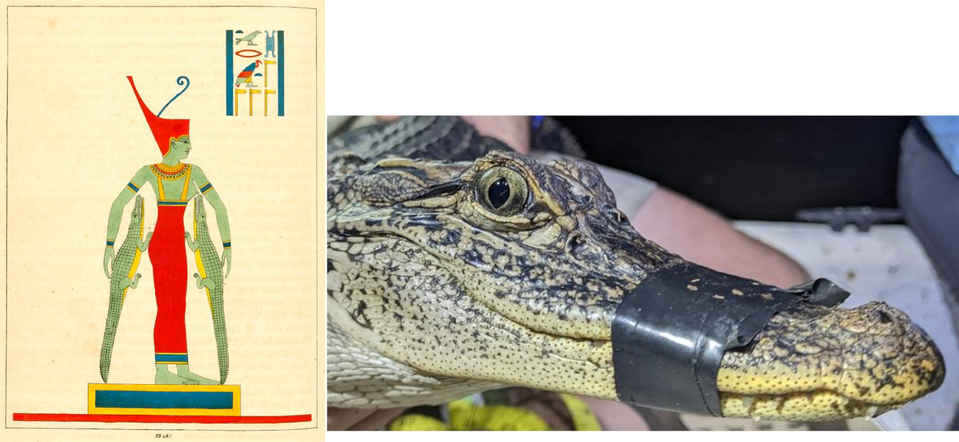
"Bouto [Neith], nourrice des Dieux." by Leon Jean Joseph Dubois. The New York Public Library Digital Collections, 1823-1825: digitalcollections.nypl.org/items/510d47d9-5bb1-a3d9-e040-e00a18064a99
Alligator’s mouth taped shut thanks to Lake Maurepas Monitoring Project, Biological Sciences Hammond, LA: https://www.southeastern.edu/acad_research/depts/biol/programs/lakemaurepas/index.html
47.29 The immobilized crocodile: Green Neith/Athena is so strong her hold could keep crocodiles’ mouth shut
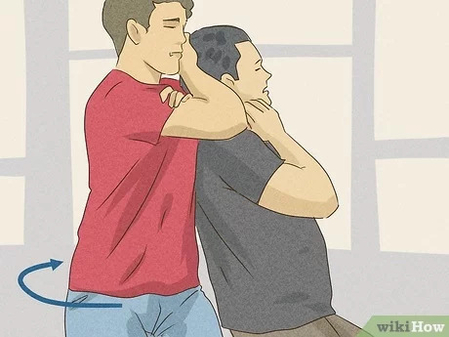
There is always something cute and funny in the explanations given by Egyptologists; for example here with Neith and the crocodiles, Neith is supposed to “suckle” them. Of course, the fact that one of Neith’s breasts is visible would confirm this idea of suckling the crocodiles, but then why is there only one breast visible?
Probably the reason of the fact there is only one breast visible is to indicate that Neith is not suckling crocodiles, but simply nursing them. The idea is to indicate the context: Neith is about when you take care of the animal and the necessity you will have at some point to keep shut its mouth.
The idea is to demonstrate the extreme power of the Neith chain: she can keep crocodiles’ mouths shut and because she is a chain made of bronze, she is turning green just like the color of the crocodile.
But the most important part of the draw is about the fact that the crocodiles are depicted just like Neith would want to immobilize them; hence the analogy with the sleeper choke hold.
• In short, this mysterious draw of Neith is all about the hold on the crocodiles, because Neith is the chain used to immobilize the crocodiles' mouth.
• And because the chains are made of bronze that turns green over time, Neith also appears with green skin.
“Neith appears as an androgynous woman. She wears the red crown of Lower Egypt. She sometimes appears in the guise of a golden cobra, too. She is customarily depicted with a green face and hands. Neith is portrayed suckling a crocodile at each breast.” https://occult-world.com/neith/
How to Perform a Sleeper Hold: Expert-Approved Instructions. A comprehensive walkthrough on how to put an attacker to sleep. Co-authored by Derrek Hofrichter and Eric McClure: wikihow.com/Do-a-Sleeper-Choke-Hold
47.30 Were there two Neith chains to operate the upper hatch in the Great Pyramid?
Now, there is something else: even if we know that Neith is the very first ancient Deity to have been worshipped, since the very beginning of the pharaonic Era, most certainly most of what we know of her came after her role in the Great Pyramid, which probably is the end game of the scientific Era; so if there are two crocodiles immobilized by Neith, it could indicate that there were two chains used to operate the upper Sekhmet hatch even if as of today, this is only hypothetical.
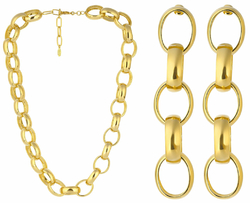
47.31 Very modern and real "Neith chains" are available to everybody... right now
The most incredible thing about the true nature of Neith/Athena being all about metal chains, is that if academic knowledge obviously forgot all about it, public awareness didn’t: just make a quick research on the internet about “Neith chain” and you’ll find hundreds of results of chains or chain earrings, just like these ones from Maison Saoula.
“Neith chain necklace” at maisonsoula.com/products/neith-chain-necklace and “Neith chain drop earrings” both from Maison Saoula: maisonsoula.com/products/neith-drop-earrings

String Lights, by Yard Envy, Alpharetta, Georgia: https://www.yardenvy.com/patio-string-lights
47.32 Neith's Feast of Lamps festival and the string/chain lights metaphor
Most probably, the Feast of Lamps festival in which a multitude of lights were burned in honor of Neith, was made so that the lamps created what would have looked like an infinite chain of lights onto the land. Lamps were arranged in a string/chain pattern: they certainly weren’t set randomly and certainly not put onto the ground.
“A great festival, called the Feast of Lamps, was held annually in honor of Neith and, according to the Greek historian Herodotus, her devotees burned a multitude of lights in the open air all night during the celebration.” https://en.wikipedia.org/wiki/Neith
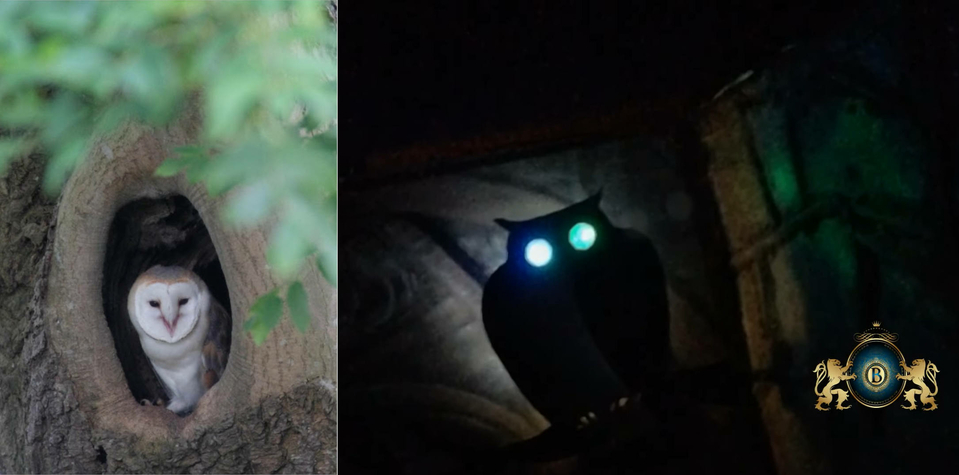
Owl peeking out of a tree hole at the North York Moors National Park, by the Whitby Photographer: https://www.youtube.com/watch?v=XNhCkmMeZ0M
Owl eyes gleaming in the dark, by Barry Belcher: https://www.youtube.com/watch?v=5BJB2BtHVqY
47.33 The Glowing Eyes of the Owl of Athena are about the Neith’s Feast of Lamps festival
The idea that the lamps burnt for Neith’s Feast of Lamps festival were most certainly arranged to create strings of light in the air, in remembrance of the bronze chains in which Neith is originating from, is actually reinforced by the most obvious emblem of her Greek reinterpretation Athena: the Owl of Athena.
There are certainly many reasons for the ancients to have chosen to use the owl as a symbol of the bronze chains that were used inside the Great Pyramid and before that, since Neith is the very first goddess known in ancient Egypt.
In the Pyramid, the Neith chains were used to operate the upper hatch from inside a wooden structure that would have looked like a tree at the top of the Gallery; and Neith was inside that tree, with the links of the chains shinning because they were made of bronze.
So, when you think it through, the Owl metaphor is perfect if you consider the shinning eyes of the owl nested inside a tree hole.
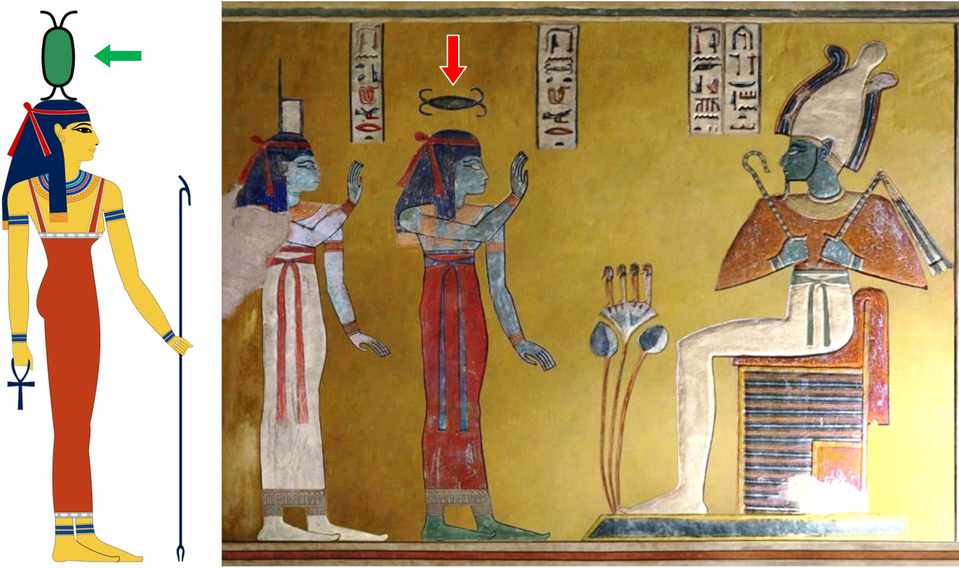
Illustration #211 (rear annex, wall 27), from the tomb of Prince Khaemwaset in the Valley of the Queens in Luxor, Egypt. Photograph by Gaspard Van Haver: tomb-khaemwaset-gaspard.info/tomb/the-rear-annex/rear-annex-wall-27/
"The Egyptian goddess Neith, the primary creator, bearing her war goddess symbols, the crossed arrows and shield on her head, the ankh, and the was-sceptre. She sometimes wears the Red Crown of Lower Egypt". Draw by Jeff Dahl: https://en.wikipedia.org/wiki/Neith
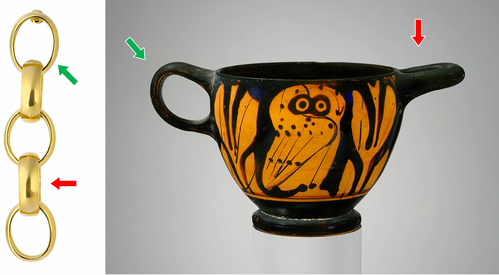
47.34 The two positions of the emblem of Neith at a 90° angle... and their green color are because Neith's emblem is a chain link made of bronze: it will turn green over time
There are many hypothesis you can find about the meaning of Neith’s emblem, and of course until I realized Neith wasn’t about a rope but about a chain, I couldn’t figure out its real meaning either.
You can read her emblem is about the click beetle, a weaving shuttle or a shield with arrows; but if there really is out there anyone who really sees all these items on the above image of Neith’s emblem, I guess we don’t have the same vision.
And by the way, the most intriguing characteristic of this emblem, is the fact that sometimes the emblem is standing up side down, while on other occasions, it looks like laying flat at a 90° angle… and about that, nobody seems to want to talk about it. So what, it probably is an error?
Well, of course there is no error. Every time egyptologists are lost and fail to understand something, either they will incriminate “robbers” (they do like robbers right; if there has been nothing found in the great pyramids, it is because robbers visited the place first… stealing everything of the so-called tombs, and among other things they stole paintings and hieroglyphic texts on the walls, etc.).
But now that we know Neith is about chains made in bronze, Neith’s emblem becomes crystal clear: it is a chain link, and it comes with some kind of attachment extensions. Probably these grappling hook-like extensions are only metaphorical, only here to point out that the emblem is only supposed to be associated with other links of its kind (or other “eyes” of its kind).
Anyway, the fact that the emblem can be represented in two different orientations, only comes from the design of the chain itself: chain links are always alternatively set in two different orientations, with a 90° angle shift.
And that is the exact same thing that is shown on the handles of the famous skyphos in which one handle is vertical and the other one horizontal.
Terracotta skyphos (deep drinking cup), Greek, Attic, mid-5th century BCE. On view at The Met Fifth Avenue in Gallery 171. Obverse and reverse, owl between olive sprigs. This work represents a type of skyphos in which one handle is vertical and the other horizontal. Because an owl is frequently the decoration, the shape is known as a glaux, the Greek word for owl Metropolitan Museum of Art, New-York: metmuseum.org/art/collection/search/254299
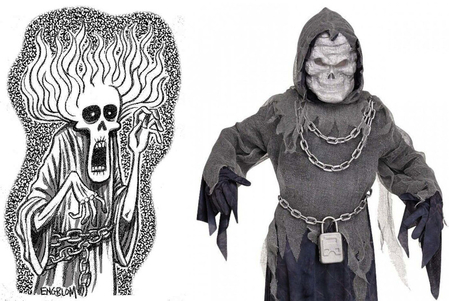
47.35 Neith was known as the “terrifying One” and Athena was associate with noise… lot of noise indeed
One way of looking at the operation of the upper hatch is as it was functioning like a very real French guillotine, with the blade getting endlessly up and down and the Neith/Athena chains being responsible for lifting the blade. In other words, the Neith/Athena chains were responsible for arming the guillotine, and if the entire structure operating the hatch, the chains and the counterpoise was closed, nobody would have ever been able to see the origin of that rattling noise.
Scary right? So maybe, the terror that could originate in ghosts carrying rattling chains comes right from the Grand Gallery. It is perfectly known that:
• Neith was called “the Terrifying One”
• Athena was associated with “making noise”, echoing Neith being associated with the click beetle.
“Neith, a borrowing of the Demotic form Ancient Egyptian: nt, likely originally to have been nrt "she is the terrifying one". https://en.wikipedia.org/wiki/Neith
“In the 6th labor, Hercules had to scare off the Stymphalian Birds from Lake Stymphalia. These birds were a menace and would terrorize those who lived in the area. To scare the birds, Athena created a noise making clapper called the krotala. Hercules used the krotala to scare off the birds.” https://www.theoi.com/articles/interesting-facts-about-athena-greek-goddess-of-knowledge/
Illustrations: "The Ghost of Jacob Marley", with chain, by mengblom on Deviant Art: https://www.deviantart.com/mengblom/art/The-Ghost-of-Jacob-Marley-334508998
And "Scary Ghost Costume with Sound FX Effects Kids Grim Reaper Halloween Fancy Dress" at https://www.ebay.com/itm/275962227542?var=578133138340
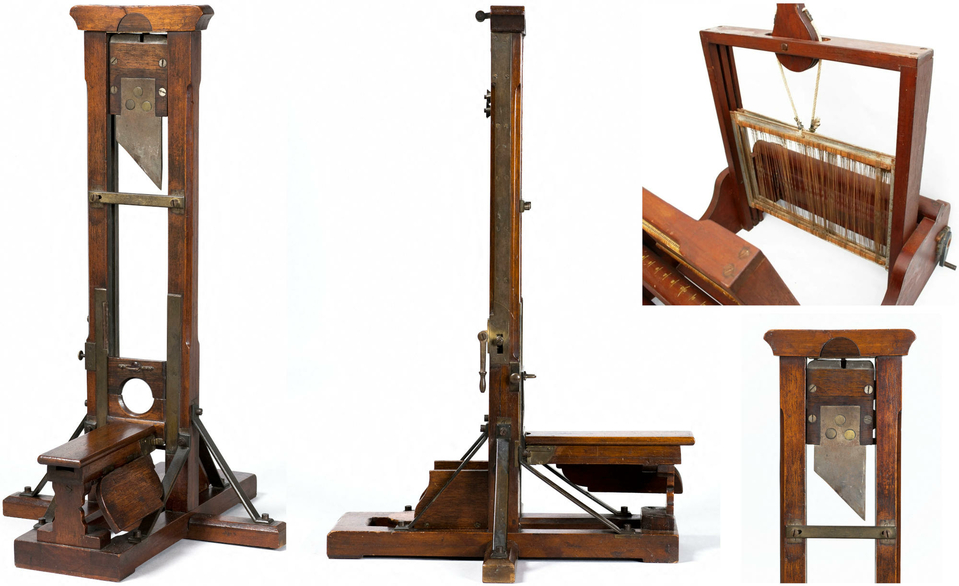
Model of a guillotine at the Musée Carnavalet, Histoire de Paris, by Alphonse Léon Berger (Perpignan, 15/02/1841 - Paris, 03/06/1906) : https://www.parismuseescollections.paris.fr/fr/musee-carnavalet/oeuvres/modele-reduit-de-guillotine-avec-le-panier-servant-a-la-reception-du-corps#infos-principales
Vintage Antique wooden table loom. Weaving tapestry 16" Primitive Shaker: ebay.com/itm/363347550746
47.36 Neith/Athena: the guillotine and weaving shuttle/loom metaphor
I thought I’ve already understood the metaphors used by ancient Egyptians about the weaving process by the way the windlass drive shaft of the platform of the Grand Gallery was operating the four ropes constantly ascending and descending the Gallery, with the endless up and down movement of the impactor in the caisson, but I probably have missed the real deal: metaphors about the weaving process, the weaving shuttle (the emblem of Neith) and the loom, probably are about the upper hatch and the wooden structure which operated this hatch.
When you think it through, an antique loom like shown on the above photograph is very similar to what would have looked like the wooden structure operating the hatch… and to a French guillotine (see below, with Serket represented cutting Apep into multiple pieces).
“As the goddess of creation and weaving, she [Neith] was said to reweave the world on her loom daily. An interior wall of the temple at Esna records an account of creation in which Neith brings forth the Nun, the first land, from the primeval waters. All that she conceived in her heart comes into being, including all thirty deities. Having no husband she has been described as "Virgin Mother Goddess". https://en.wikipedia.org/wiki/Neith
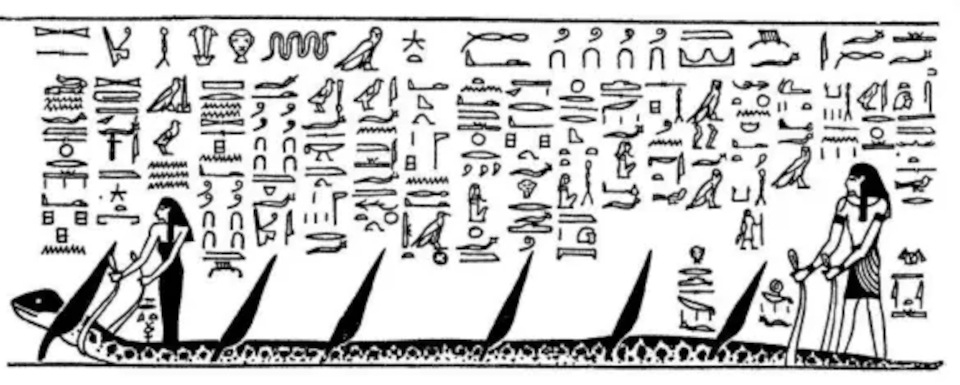
47.37 Serket is the one who was literally “cutting Apep into pieces”
Serket killing cutting Apep into multiple pieces. Detail from the tomb of Seti I. XX Dynasty: the serpent Neha-hra [Apep, Apophis] being fettered by Serqet and Her-tesu-f. Image from page 143, Chapter VII of The Book of Am-Tuat by E. A. Wallis Budge [1905]. Excerpt: "He who is in this picture is Apep, and he surroundeth his country, which is in the Tuat; TCHAU is the name of this district, which is four hundred and forty cubits in length, and four hundred and forty cubits in breadth, and his voice guideth the gods to him. He who is with (?) him after this great god hath made his passage through this City, halteth (?) with AFU, opposite to the country whereover he would make a way; behold, SERQET is at the head [of Apep], and HER-TESU-F placeth his deadly fetter about his feet after Isis hath taken possession of the words of power of SER of two-fold strength, [and Ra] giveth their it words of power. Whosoever knoweth it (i.e., this picture and the text) upon earth shall not be one of those of whose water NEHA-HRA drinketh." https://sacred-texts.com/egy/bat/bat10.htm

Operation of the Grand Gallery of the Great Pyramid of Giza. The impactor is locked and secure by the Sekhmet upper wooden hatch, ready to be released. The hatch is always in perfect balance with its counterpoise (that is what Ma'at is all about). On this draw two kinds of glorifications have been used: the original ancient Egyptian deities (like Ra, Osiris, Isis, Neith, Sekhmet…) and some of their Greek reinterpretations (like Athena for Neith, or the “Shield of Athena” for the upper hatch Sekhmet). Last updated April 5, 2024.
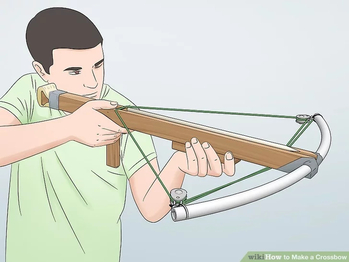
47.38 Athena of the Eye and the wisdom and war metaphors are about operating a bow or crossbow
If the reason why Athena had been the goddess of wisdom is obvious because she was made of a multitude of Eyes (she was clairvoyant and far-sighted), the reason why she also had been a war goddess is more difficult to understand.
But look again at the draw I’ve made of the upper hatch, when the Sekhmet hatch is in a seated position and is immobilizing the impactor in a secured position ready to be launch; and now imagine the Athena chain lifting the hatch and releasing the impactor into the central wooden wind pipe caisson… doesn’t it look like the release of an arrow out of a bow? Or out of a crossbow? How to Make a Crossbow: https://www.wikihow.com/Make-a-Crossbow
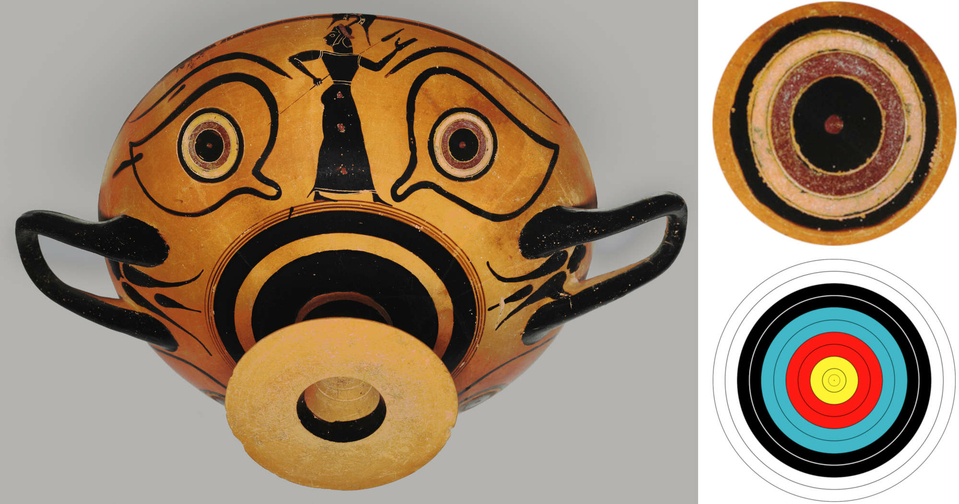
Eye Cup of Athena at the Harvard Art Museums. “The exterior of this cup is a set of two pairs of eyes on either side, with the figure of the goddess Athena in the middle in place of a nose. The eyes are large and opened wide with exaggerated tear ducts. Their irises and pupils are rendered as target-like circles, using added white and added red in addition to a bold black outline. Above the eyes are slim and curvaceous eyebrows. The Athena in the center, on either side of the cup, faces right with her head turned over her shoulder. The plume of her helmet extends all the way up to the rim of the cup. On one side, she points her spear to the right, extending her other hand outwards. Her helmet, shirt, and skirt are decorated with added red. On the other side, her spear is pointed upward, her pose much narrower. Though her aegis is not decorated with red, her helmet and skirt are.” https://harvardartmuseums.org/collections/object/288461?position=3
An unofficial drawing of the 80 cm archery targets used by the World Archery Federation. By Alberto Barbati: https://en.wikipedia.org/wiki/Bullseye_%28target%29#/media/File:WA_80_cm_archery_target.svg
47.39 Bull’s Eyes! Why the figure of Athena is in the middle of the face on Eye cups where the nose should be
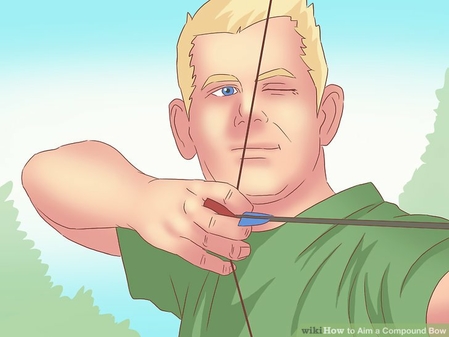
Everyone knows that one of the most important recommendations for a correct aiming when using a bow is to “align the bowstring with the center of your face, specifically your nose”*; and that is what the above Eye cup of Athena is all about: aligning the bowstring with the center of your face.
Of course, the “target-like circles” of the Cup are about real archery targets: they are here to point out that Athena is all about releasing the arrow, even if this is not really about a real arrow but about the release of the impactor, and not really about a bowstring but about (probably two) chains under “tremendous” tension.
In short, when Athena is represented in the middle of the face on the Cup where the nose should be, this really is about the bowstring being released, because the bowstring is in fact the chains releasing the impactor.
* https://nightgalaxy.com/blog/post/how-to-aim-a-recurve-bow
Illustration: How to Aim a Compound Bow, co-authored by Clay Hayes: wikihow.com/Aim-a-Compound-Bow
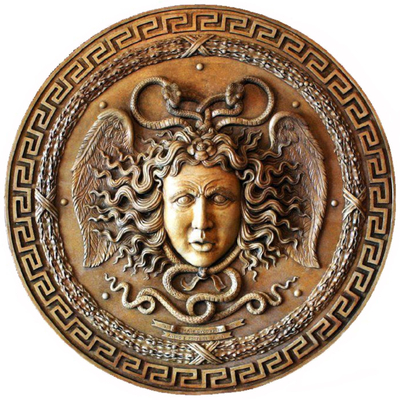
47.40 The Gorgon on the Aegis "Shield" of Athena
Now that we know that the Aegis “Shield” of Athena is the upper hatch of the central wooden caisson wind pipe of the Grand Gallery, comes the problem of the Gorgons, the Three Gorgon sisters: if the head of a Gorgon is often represented onto the Aegis “Shield” of Athena, it is because the Three Gorgons are about a very particular piece of equipment that came with the hatch.
“Homer mentions only "the Gorgon" giving brief descriptions of her, and her head. In the Iliad she is called a "dread monster" and the image of her head, which appears—along with several other terrifying images—on Athena's aegis, and Agamemnon's shield, is described as "dread and awful", and "grim of aspect, glaring terribly". https://en.wikipedia.org/wiki/Gorgons
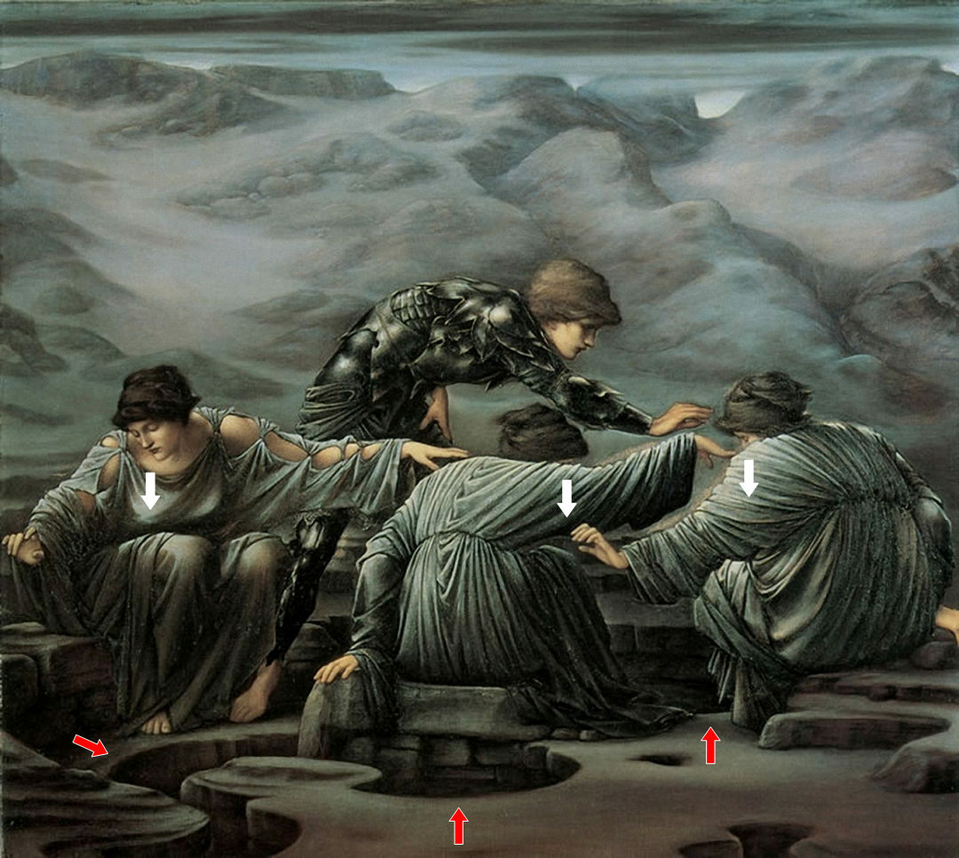
Perseus and the Graeae by Edward Burne-Jones (1892), showing mysterious “wrinkles” in the ground and the Three Sisters only staring at these same "wrinkles", simply because they really are these "wrinkles": https://en.wikipedia.org/wiki/Graeae#/media/File:Edward_Burne-Jones_-_Perseus_and_the_Graiae,_1892.jpg
47.41 The wrinkles of the Three very old Graeae sisters are about the hatch's grooves
And the answer to the Three Gorgon sisters comes also with their other Three Graeae sisters.
Usually, you would say about theses Three Gorgon sisters (Stheno, Euryale and Medusa), along with their other Three Graeae sisters (Deino, Enyo and Pemphredo ), that they were actually the Six sisters; but Greeks never talk about them as the Six sisters; they were two “sets” of Three sisters only.
Their meaning is actually all about the problem Egyptians were facing trying to keep pressurized air inside the central air pipe caisson with an internal hatch: it is easy to get the lower hatch airtight, but not the upper internal hatch. So Egyptians solved the problem, with the exact same solution that we are using today to get sliding windows airtight:
• they got the hatch to slide inside wooden grooves…
• and they used airtight stripping brushes.
And the thing is, they only needed to take care of three parts of the hatch:
• the left and right side of the hatch
• the bottom part of the hatch
They didn’t care about the upper part of the hatch, because it was only another “Bastet” hatch itself: very easy to get airtight.
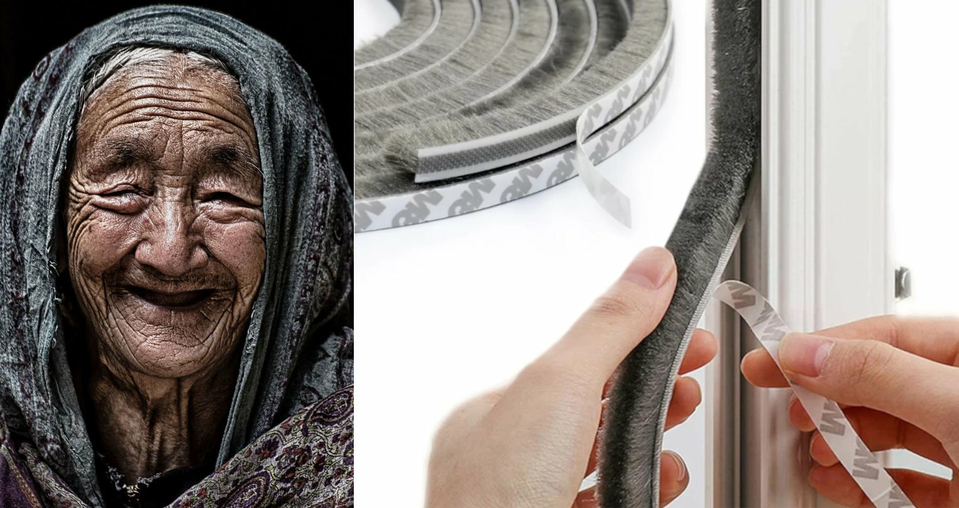
The fact that the airtight stripping brushes can look just like a coiled snake, is probably the main reason why the myth is representing snakes instead of hair around the head of Medusa in the first place; but probably there would actually be many different additional reasons for this particular aspect of the Shield of Athena.
Old wrinkled woman, photograph by Alicia Rodriguez: https://www.flickr.com/photos/146873462@N03/
Sliding Door Seal Strip at https://www.flipkart.com/hasthip-10-meters-soundproof-window-sealing-strips-windproof-dustproof-door-frame-seal-self-adhesive-brush-strip-sliding-seal-strip-grey-mounted-stopper/p/itm722460671a485
47.42 The airtight problem of the internal hatch resolved by three grooves and three stripping brushes
So, when Greeks reinterpreted the whole thing, they used two beautiful metaphors:
• the special hair of the Gorgon to represent the hair of the airtight brushes: “Pindar makes snakes for hair explicit, saying that Perseus' Gorgon head "shimmered with hair made of serpents", and that the Gorgons chasing Perseus also had "horrible snaky hair", so too in Prometheus Bound where all three Gorgons are described as "winged" as well as "snake-haired".” https://en.wikipedia.org/wiki/Gorgons
• the very old age of the Graeae to represent the grooves in which the hatch was sliding up and down: the metaphor is about the wrinkles of the Three sisters. Wrinkles are the signature of old age.
47.43 Edward Burne-Jones still had a piece of the puzzle at hand
If you look at the painting by Edward Burne-Jones, just like we’ve already seen many times (in the Emerald Tablet Section 35 for example), these deep “wrinkles” are even represented in the picture; and just like the grooves were probably cut deep inside the wooden structure of the caisson, the “wrinkles” in the painting are also cut deep into the ground.
What it means, is that Edward Burne-Jones, somehow knew the metaphor of the wrinkles about the Graeae, and again if he understood the wrinkle metaphor, it doesn’t mean he knew what it was all about. But still, the painting was created in 1892, and it is very close to us right? Anyway, I find pretty interesting and quite touching to see that about just over 100 years ago, some pieces of the puzzle of how to reconstruct the design of the Grand Gallery’s operation were still available to some people, what ever the extent of their knowledge they got.
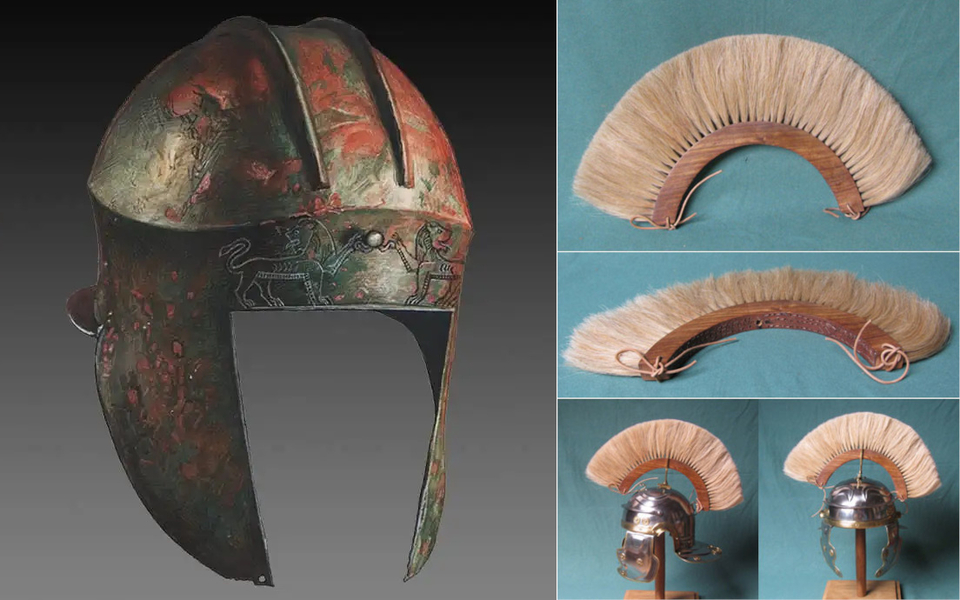
The guiding groove... on a Illyrian type Helmet, 450-20 BC, northern Greece”. Robert C. L. Holmes, The Collector: https://www.thecollector.com/ancient-greek-helmets-8-types-and-their-characteristics/
The stripping brush... on a wooden crest for Roman Deepeeka helmets. Medieval Arms: https://www.medieval-arms.co.uk/detail/id/1588/name/beige-crest-wood-for-roman-deepeeka-helmets
47.44 The Helmet of Metis... and the Greeks' enemies pounded to death by the ramming "gate"
Sometimes, it is just one single word that is the key for the understanding of a particular metaphor, and here the word that allows us to understand Metis, is “helmet”: the “helmet of Metis”.
We’ve already seen that Zeus is the reinterpretation of the central wooden wind pipe caisson, so when it is said in the following excerpt that “inside Zeus's body, Metis began crafting a helmet”, that “helmet” can only be about one very particular thing: the hatch itself; the “sluice gate-like” hatch.
But it doesn’t answer the question of why are they talking about a helmet, instead of a Shield?
Why when it comes to Matis, the Shield of Athena becomes the helmet of Matis?
The answer to these questions is because if both the Shield and the Helmet are about the hatch, they are actually about two different aspects of this hatch:
• the Shield (of Athena and Zeus) is about its protecting capabilities to contain pressurized air inside the caisson.
• the Helment (of Matis) is about its shape: the sluice gate-like hatch did resembled to a helmet.
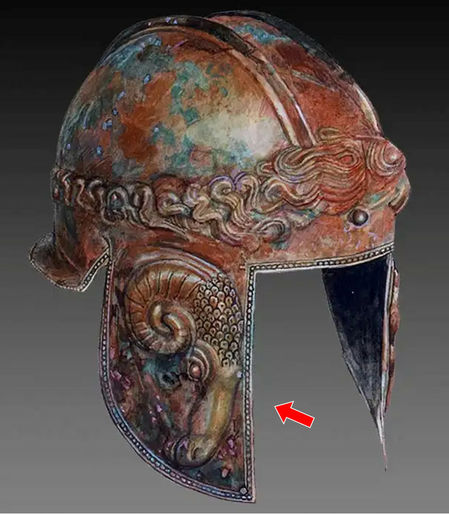
Just look again at the basic draw of the Matis/Sekhmet upper hatch I’ve made in the Grand Gallery’s operation diagram, and you should see the helmet right away.
What I need to point out at this point, is that I only read about the “Helmet of Metis” four or five days after having drawn the Matis/Sekhmet upper hatch on the diagram, so I wasn’t influenced in any way in the basic design of the hatch: it was only the result of constraints due to the slope of the Grand Gallery and the obvious necessity that the hatch not only had to constraint air in the caisson but also had to be the one piece of equipment to secure the impactor at the end of the hauling process, but also to release it at the beginning of another operating cycle of the Gallery.
Of course, the famous crest that is on top of Greeks and Romans’ helmets, are all about the Helmet of Metis, and the airtight brushes that were accompanying the sluice gate-like hatch: by wearing their helmets, Greek soldiers were assimilating themselves to the extreme ramming and hammering power of the upper hatch so that they could pound their enemies to death.
Illyrian type Helmet showing a hammering ram, 535-450 BC, Trebenista, Macedonia. The Collector: https://www.thecollector.com/ancient-greek-helmets-8-types-and-their-characteristics/
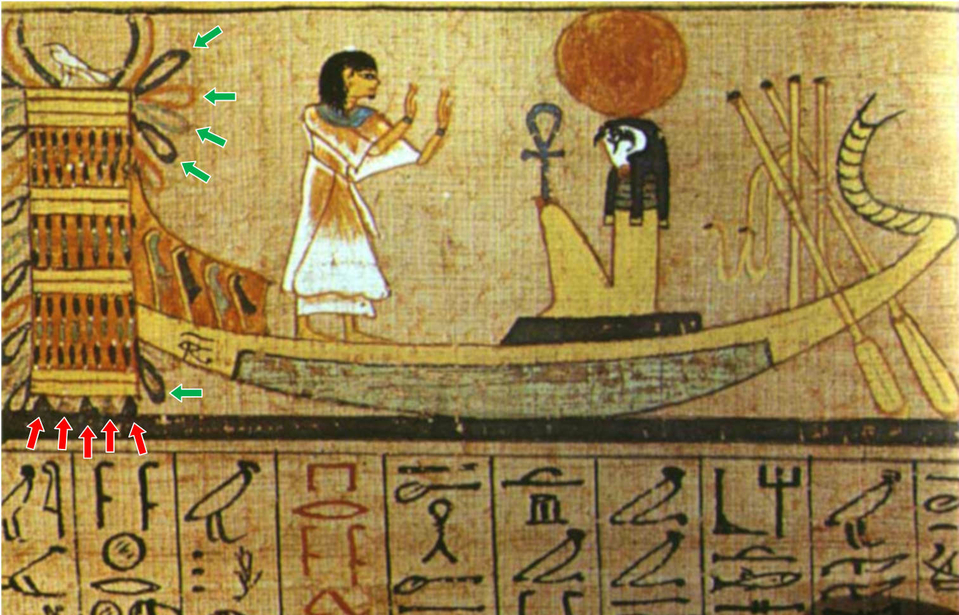
The representation of the three airtight strip brushes in the Egyptian scene of the Solar boat anchored by the upper hatch: two on each side of the hatch and one (half crushed) on the ground.
47.45 The original representation of the airtight stripping brushes in ancient Egyptian art (above image)
47.46 Why there are two immortal Gorgons and only one mortal: Medusa
There is only one mortal Graeae because the two lateral ones (the two lateral stripping brushes) wouldn’t have been compressed by the weight of the Metis/Sekhmet hatch: only the one at the bottom, assuring the airtightness with the floor of the caisson would have been crushed by the hatch.
“The Graeae were known above all for their connection with Perseus and his heroic quest to slay Medusa. In this popular tale, Perseus had been sent to kill Medusa, the only Gorgon who was mortal—a seemingly impossible task, as Medusa’s gaze turned all who looked upon her to stone. Perseus, however, was no ordinary man: he was the son of Zeus himself, and the gods rallied to help him defeat his foe.” https://mythopedia.com/topics/graeae
“They were grey-haired from birth and shared amongst themselves a single, detatchable eye and tooth.” https://www.theoi.com/Pontios/Graiai.html
47.47 The Eye on the solar boat and the connecting part on the upper hatch
This scene of the solar boat, being literally anchored by that weird element that is the upper hatch is of course priceless, because it is the affirmation that it is the hatch itself which was both securing the impactor in a locked position, and released the impactor. On this image, you’ll note that the “piece of the hatch” that is anchoring the boat with all its weight is right on top of a little Eye of Horus.
This little Eye of Horus doesn’t seem very important here, but it is of tremendous importance: this little Eye, that is the bollard onto which the hatch is holding, just like I tried to represent on my diagram of the operation of the Gallery (of course, because there was two Eyes on the impactor for the two Isis hauling ropes, there would also have been two connecting parts onto the hatch, a left one and a right one).
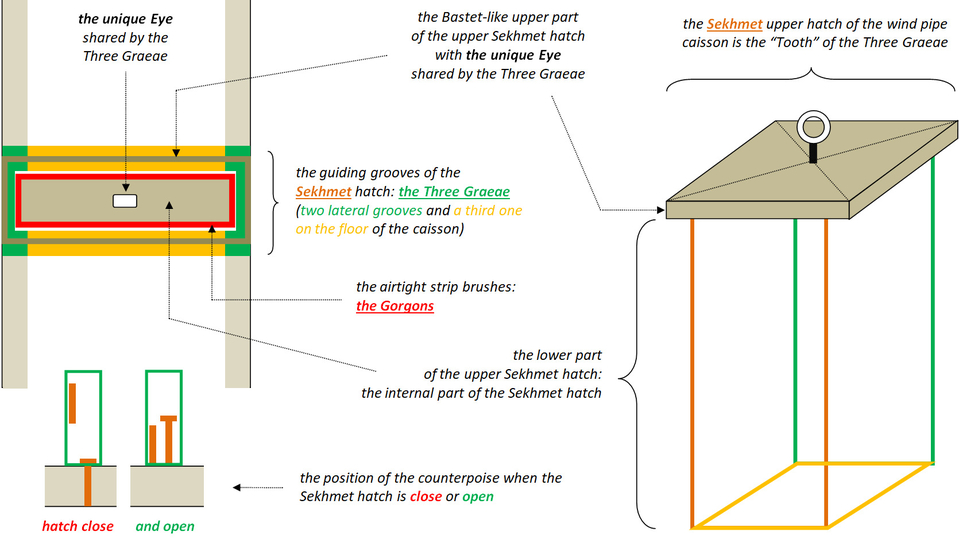
Hypothetical basic design of the upper internal hatch of the central wooden caisson that has been deified into the Egyptian goddess Sekhmet and the Greek goddess Metis, and showing the only one eye shared by the Graeae and the "detachable tooth", the hatch itself.
47.48 The Aegis that needed to be shaken… and looked like a tooth
These are some excerpts in French about the Aegis (l’Égide) which are giving us more details about the device:
• the Aegis needed to be “shaken” (“secouée” in French, “en secouant l’égide…”)
• The Graeae shared an Eye and a Tooth (of course, the “Tooth” is the hatch itself)
• there is an Aegis in botany which is about the female cone of the pine
I didn’t find this descriptions in English, but they are precious because the hatch actually really needed to be shaken (the same movement which gave us the metaphors about the loom of Athena and the weaving shuttle of Neith, but also because the most obvious characteristic of the female cone of the pine is that it is made of many elements looking like a tooth, which was pretty close to what the hatch would have surely looked like.
“Théophraste parle d'un Aigis dans son Histoire des Plantes (III, IX 1-3), en parlant du sexe des arbres : "car c'est le pin femelle qui comporte ce que l'on appelle l'aigis “.
« En secouant l'égide, Zeus déclenche le tonnerre et les éclairs, semant ainsi la terreur parmi les mortels : “De son côté, le fils de Cronos saisit son égide Aux mille franges d'or : il couvrit l'Ida de nuages, Lançant l'éclair à grands fracas et secoua le mont, Donnant la victoire aux Troyens et faisant fuir les autres. “
“L'égide est l'œuvre d'Héphaïstos — ou, chez Hésiode, de Métis, pour sa fille Athéna. Au chant II (v. 446-449), Homère la décrit ainsi : « la précieuse égide, inaltérable et pure, D'où pendillaient cent franges merveilleusement tressées, Tout en or fin, et dont chacune valait bien cent bœufs“. https://fr.wikipedia.org/wiki/%C3%89gide
https://fr.wikipedia.org/wiki/C%C3%B4ne_%28botanique%29#/media/Fichier:Pinus_coulteri_MHNT_Cone.jpg
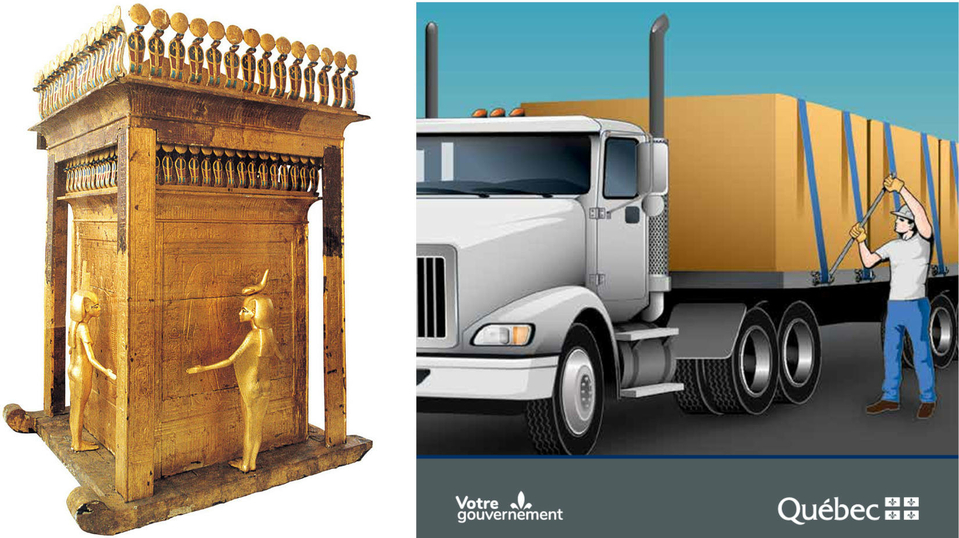
“This shrine was found in the so-called Treasure Room, with an alabaster container inside within which there were four canopic vases with four miniature sarcophagi for the internal organs of the king. The shrine, placed on a sled, is surrounded by two friezes of cobras with the solar disk. On every side of the shrine, there is a goddess with open arms to protect the canonic vases: Isis, Nephthys, Neith and Selket.” Place of discovery: tomb of Tutankhamun, Valley of the Kings: egyptianmuseumcairo.eg/artefacts/shrine-for-canopic-vases/
Cargo securement illustration thanks to Gouvernement du Quebec: transports.gouv.qc.ca/en/camionnage/arrimage-cargaisons/Documents/cargo-securement-guide-2017.pdf
47.49 Isis, Nephthys, Neith/Athena and Serket are all about ropes and chains tied together
There was in the tomb of Tutankhamun, a magnificent golden shrine with four goddesses on its sides: Isis, Nephthys, Serket and Neith and it is said that these four goddesses are represented “holding hands”, if we believe the academic explanation of their posture. It is probably true, in some ways: metaphorically they all could be represented “holding hands”, but I think a better way of describing their posture would be to see them “tied together”.
We’ve already seen in previous Section 46 that when Isis is the glorification of the two hauling ropes of the impactor of the Great Pyramid (Isis was known as “the Ascending One”), Nephthys was about these same two ropes released into the Grand Gallery after the end of an operating cycle of the Gallery (Nephthys was known to be “ the Descending One”).
Like I said before, I thought that if these two goddesses are about ropes and represented in a posture where they are apparently holding hands with the two other goddesses, then Neith and Serket were also about ropes simply because the four of them are all represented in the exact same posture on Tutankhamun’s shrine.
We know now that this idea of the shrine being secured by four ropes is wrong, because Neith and Serket aren’t about ropes but chains, but the idea is the same: the shrine had to be secured onto the sled, and that is the role of the four goddesses: they are securing ropes and chains.
We already know that Isis and Nephthys are actually the same two central hauling ropes (the one inside the wooden air pipe caisson), ascending and descending the Gallery and because Egyptians were obsessed with balance, it means that if Neith/Athena is the glorification of the ascending chain operating the upper hatch, then Serket has to be about the chains lowering down the upper hatch.
• Isis was known to be “the ascending One”
• Nephthys was known to be “the descending One”
• Neith/Athena is about the ascending chains
• Serket is about the descending chains
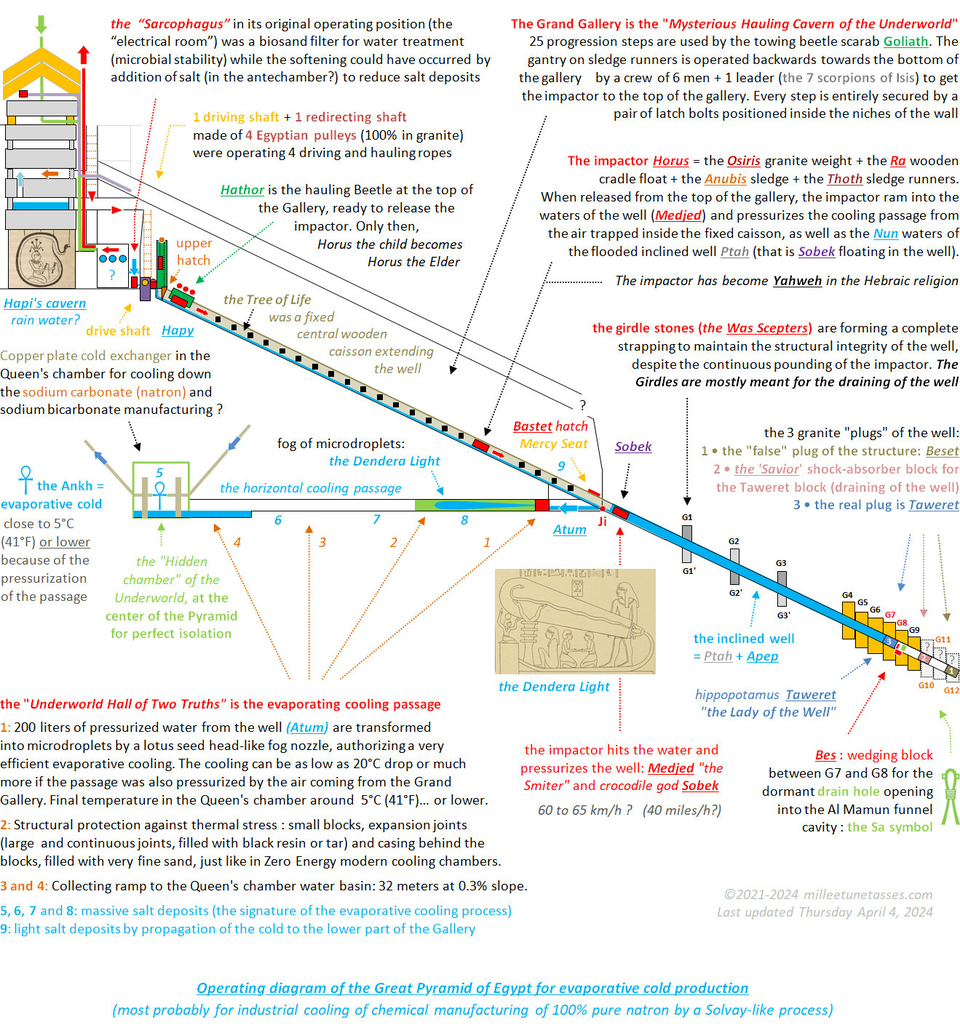
47.50 Operation of the Great Pyramid for evaporative cold production by flash evaporation
At the time of operation the Pyramid was only at the stage of construction of a "classical" mastaba. Implementation of the internal upper hatch of the central wooden wind pipe caisson glorified into the ancient Egyptian goddess Sekhmet and the Greek goddess Metis, operated by the Athena chain(s). Last updated April 4, 2024.
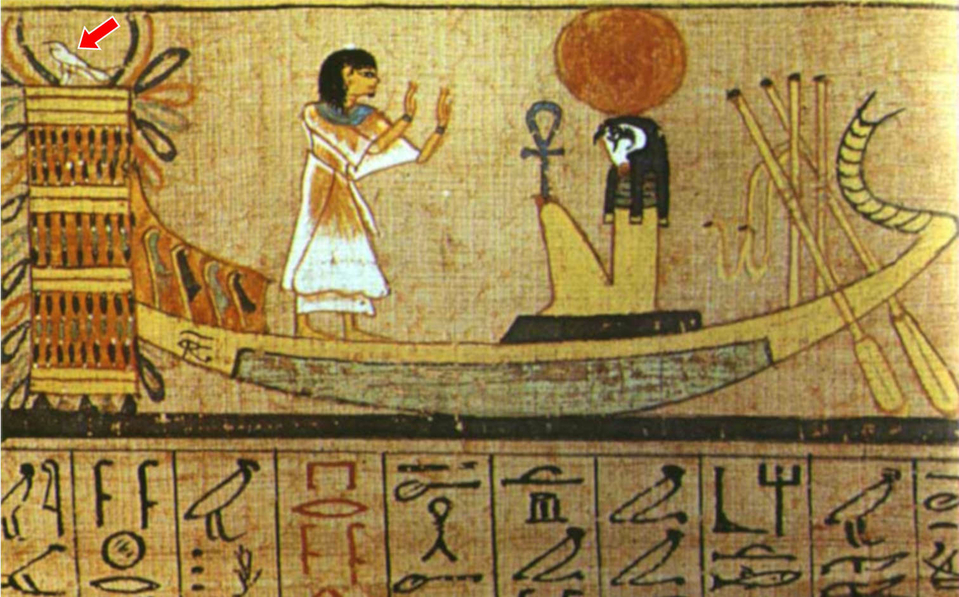
The little bird put onto the hatch is probably about the pecking metaphor.
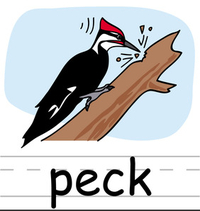
47.52 The upper internal hatch and the pecking metaphor
We’ve already seen many metaphors describing the operation of the upper internal hatch (the guillotine, the weaving shuttle, the sluice gate, the cat flat for its upper part), but I think there is one more here with the tiny little bird set onto the hatch.
Of course, this probably is this little bird in which originate the Owl of Athena, but I don’t think this bird is about the lifting chains in bronze: this little (Egyptian) bird has nothing to do with the Greek Athena.
My opinion, but I may be wrong here, is that the bird on the Egyptian original representation of the hatch securing the impactor before its release, is only about what the hatch looked like and how it was operated. I think Egyptians used here the pecking metaphor:
• the hatch would have looked like the peck of a bird, by its basic shape
• the hatch would have looked like endlessly pecking the floor of the caisson, just like a bird would do
Pecking bird illustration: https://www.abcteach.com/resource/clip-art-basic-words-peck-color-poster/
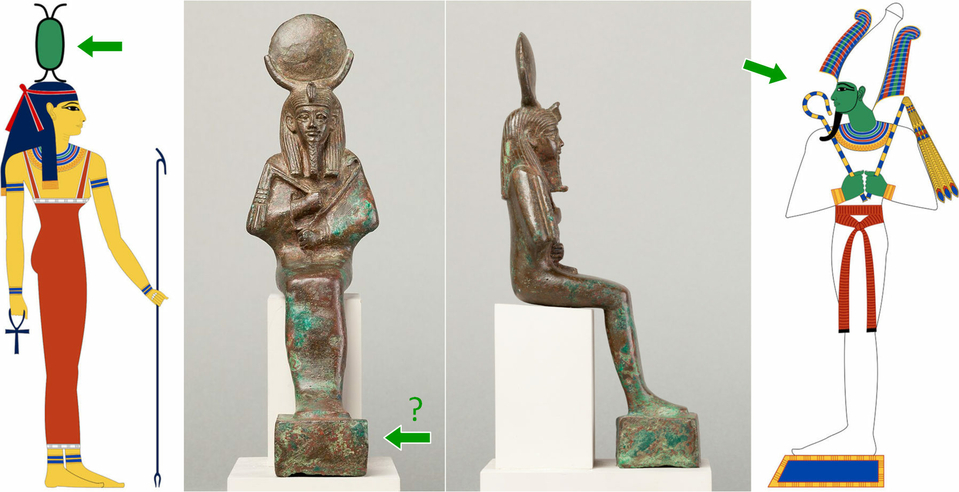
Osiris-Iah figure showing the Osiris weight at the MET: https://www.metmuseum.org/art/collection/search/548421
47.53 Was the Osiris weight made of stone or bronze... just like every other "weight"?
• Because I’ve never “approached” the bronze material so far, so to speak, I only considered the possibility that the Osiris weight was made of stone, and most of the time I refer to it at the “Osiris stone”. I thought that the green color of the body of Osiris, face and hands, were because it was related to the fact that Osiris was, because of the “seed metaphor”, the god of Agriculture.
But now that we know that the emblem of Neith really is a chain link in bronze that turned green, the more I think about it and the more I believe now that there was no Osiris stone, but a real Osiris weight made of bronze. 4,500 years ago, it was the Bronze Age, if ancient Egyptians wanted to glorify anything, it would have been bronze itself, and they would have certainly made the Osiris weight in that bronze material.
And that idea echoes a part of the Osiris myth that always had troubled me, talking about some metal poured into the wooden coffin where Osiris had been tricked in.
“Seth secretly measured the body of Osiris and had made to the corresponding size a beautiful chest which was exquisitely decorated. He brought the chest to a banquet, and when the guests showed pleasure and admiration at the sight of it, Seth promised playfully that whomever would lie down in it and show that he fitted it, should have the chest as a gift. They all tried one by one, and since no one fitted into it, Osiris went and laid down. Then the conspirators ran and slammed the lid on, and after securing it with bolts from the outside and with molten lead poured on, they took it to the river and let it go to the sea.” Source: https://www.virtual-egyptian-museum.org/Collection/FullVisit/Collection.FullVisit-JFR.html?../Content/MET.MM.00122.html&0
• Also there is something I haven’t seen until today in the above excerpt, when it is mentioned the idea of “running” and “slamming”, considering the “beautiful chest” was actually about the impactor sliding into the Gallery before ending up in the still waters of the inclined well. “Then the conspirators ran and slammed the lid on, and after securing it with bolts from the outside and with molten lead poured on, they took it to the river and let it go to the sea”.

© 2021-2024 Copyright milleetunetasses.com. All rights reserved.
The Pyramids of the Cold version 2 (May 2023 - May 2024)
Summary of the study and Table of Contents
Part A: The evaporative cooling process
Section 1 • The horizontal evaporative cooling passage layout
Section 2 • The Dendera Light and the creation of the fog of microdroplets by the fog nozzle
Section 3 • The water cycle glorifying metaphors: Geb, Shu, Nut, Tefnut
Section 4 • The theorization of the evaporative cooling process by Akhenaten and Nefertiti
Section 5 • The theorization of the evaporative cooling process in the Weighing of the Heart
Part B • The inclined well of the Great Pyramid of Giza
Section 6 • The inclined well layout and the girdle stones
Section 7 • The Taweret "Lady of the Well" temporary sealing granite plug of the well
Section 8 • The Bes temporary wedging block immobilizing Taweret
Section 9 • The draining of the well
Section 10 • The Great Serpent Apep and the snake water metaphors
Section 11 • The Was scepter and the control over "snakes"
Section 12 • The beating Heart of the Great Pyramid
Part C • The composite impactor of the Great Pyramid (Horus, Ra, Osiris, Medjed, Sobek...)
Section 13 • The wooden and stone composite design of the impactor: Ra and Osiris
Section 14 • The endlessly immersed Osiris stone and the seed metaphor
Section 15 • The Anubis sledge and the bobsled mask
Section 16 • The sledge runners of the impactor: Thoth
Section 17 • Medjed: the smiter nobody can ever see
Section 18 • The Apis bull and the ramming impactor's metaphors
Section 19 • The crocodile god Sobek impactor (more or less) floating in the waters of the well
Section 20 • The Obelisk and the Benben stone rising from water
Part D • The Grand Gallery's of the Great Pyramid of Giza
Section 21 • The Sacred "sloping paths" of the "oval-shaped cavern of the act of Hauling"
Section 22 • The central wooden caisson of the Gallery: Sekhmet and the Triad of Memphis
Section 23 • The hauling ropes of the Grand Gallery: Isis, Nephthys, Hatmehit, Wadjet and Nekhbet
Section 24 • The hauling Beetle and the Seven Scorpions of Isis
Section 25 • The Great Cow goddess Hathor and the operating cycle of the hauling Beetle
Section 26 • The 10 operating phases of the Grand Gallery
Section 27 • The guide to the Afterlife for the smart traveler and the canopic jars
Section 28 • The scarab amulet glorifications of the hauling Beetle
Part E • The very large and roughly finished sarcophagus of the Great Pyramid
Section 29 • The biosand filter sarcophagus of the Great Pyramid
Section 30 • The Elephantine Triad deification of the biosand filter of the Great Pyramid
Section 31 • The Great Pyramid's operating flat roof and the water supply issue
Part F • Chemical manufacturing and industrial cooling before the Great Pyramid
Section 32 • The Serdab and the "Refreshment of the Gods" Step Pyramid of Djoser
Section 33 • Sneferu's Red Pyramid and the accumulated ammonia
Section 34 • The Disc of Sabu and the Solvay process for pure natron manufacturing
Part G • The tremendous impact of the Great Pyramid on the whole ancient world
Section 35 • The hidden secrets of the Hermetica Emerald Tablet (around 1600 C.E.)
Section 36 • Thor and the magical Hammer in the Great Hall of Bilskirnir
Section 37 • The Churning of the waters of the Ocean of Milk (Hindu mythology)
Section 38 • The Tibetan prayer wheels and the Grand Gallery's operation
Section 39 and Conclusion • The cooling water of spitting Kebechet
Part H • Epilogue
Section 40 • The smiting Ark of the Covenant and the Ten Commandments
Section 41 • The 293 kilograms windlass Staff of Moses and Aaron... and the First Plague of Egypt: water turning into blood
Section 42 • Ezekiel's Four Egyptian pulley "Wheels within the Wheels" and the four angel ropes
Section 43 • David, Saul, two giant Goliaths, five little stones, an aeolian harp... and a weaver's beam
Section 44 • The holy water fonts and the biosand filter
Part I • The magicians of the Great Pyramid of Giza
Section 45 • The Legend of Khufu and the "magician" polymath Imhotep
Section 46 • The two magical eyes of Isis and the brilliant but painful flame of her twin sister's braids
Section 47 • The Aegis Shield of Athena "Subduer of the Winds" and the upper hatch of the central wooden caisson
Section 48 • The Seven Magical Words spoken by 'Divine Sealer' Goddess of Arrows and Bronze Neith
Poster un commentaire
